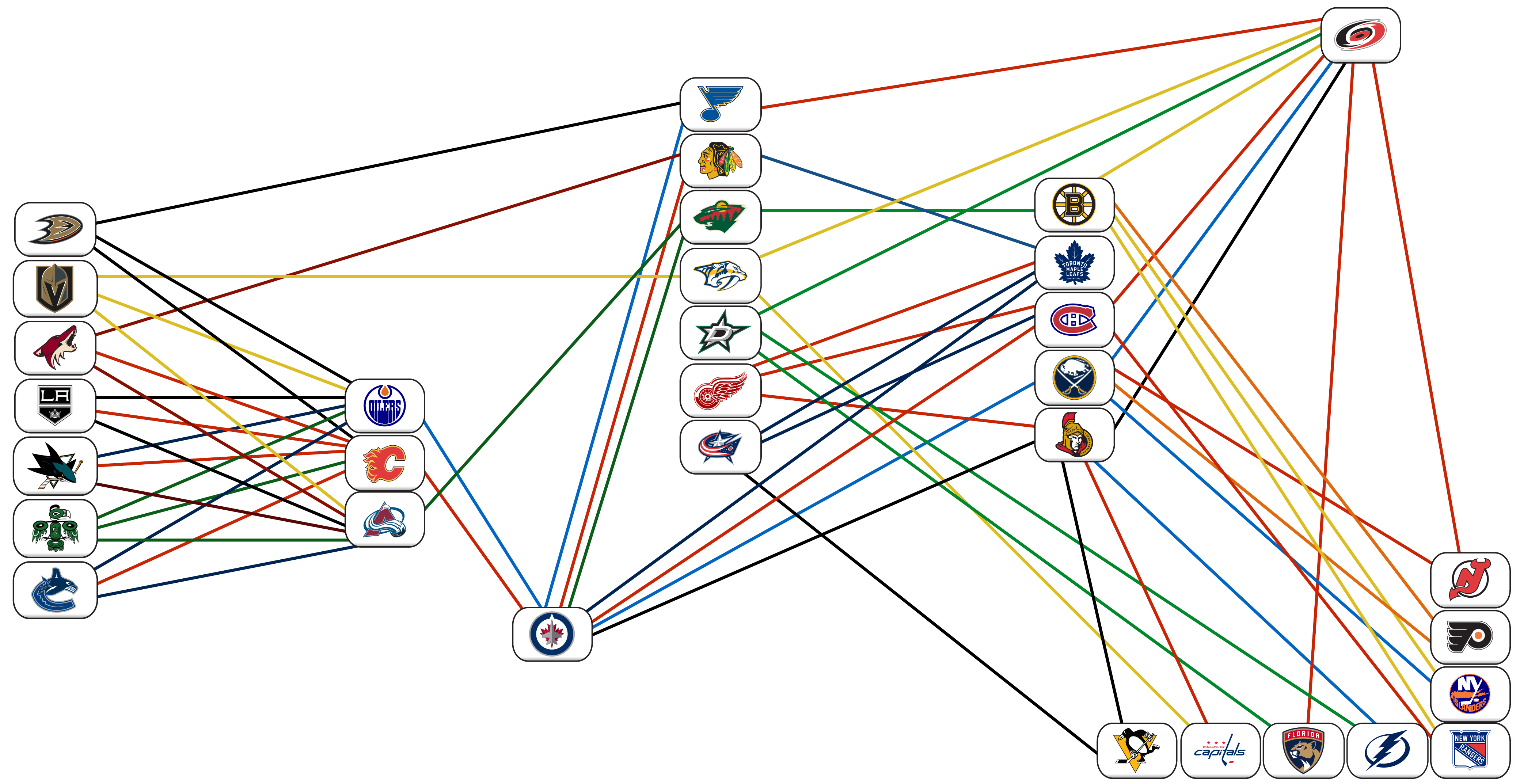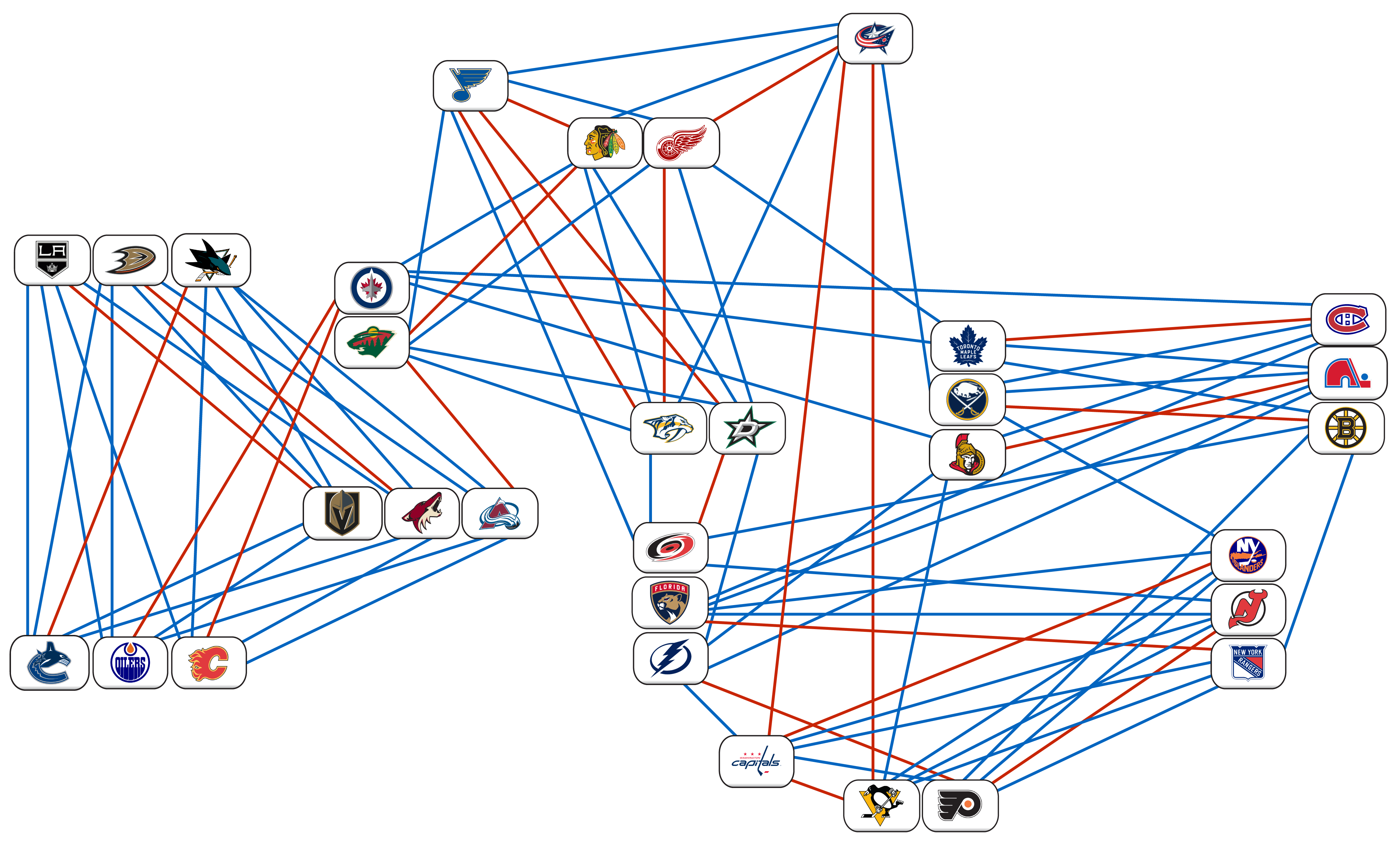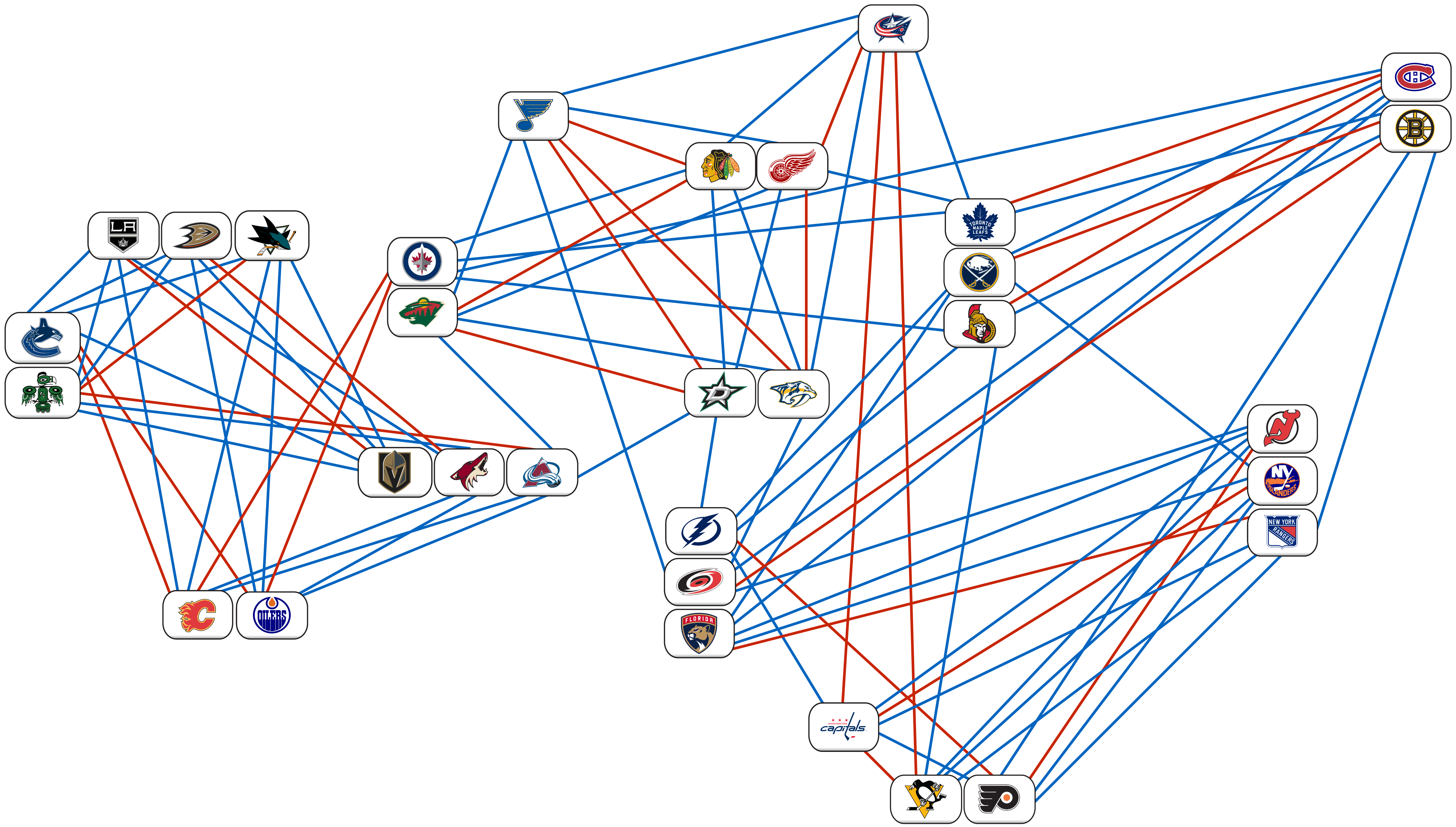Alignment Format Explorations
My early conference and division alignment concepts are widely applicable to the NHL, but I focused on concepts that include various expansion scenarios, since there are a number of issues that seem likely to crop up with a 32-team league (or more), and these were conceived of at a time where a 32nd NHL team was a hypothetical possibility, and not reality, as it is now with the Seattle Kraken having joined the NHL.The 4-division model of the current NHL worked well prior to the Seattle expansion because it was simple to make each division not span any more that 2 time zones, but that could not have continued unless Team 32 was to a city in the Mountain or Central time zone, which was unlikely given the most probably markets for expansion. Here are the best exploratory concepts I came up with, including some scenarios in which Quebec City receives an expansion team instead of Seattle, and a few with expansions beyond 32 teams. For Seattle expansion scenarios, I used the logo and name of the old WHL Seattle Totems to represent a hypothetical Seattle team:
Having 4 conferences or divisions works well for a 32-team league, under the assumption of 8 teams per conference/division. However, now that the Vegas Golden Knights are officially the 31st NHL team, this alignment will become complicated. There would have been either 9 Pacific/Mountain teams (if Seattle joined), or 17 Eastern teams (if Quebec joined), forcing at least one division in this format to span 3 time zones.
I have explored some of the best ideas to deal with these scenarios, and several 4-division splits of the NHL’s teams that have a wide range of resemblance to today’s divisions:
Minimally Changed Alignment
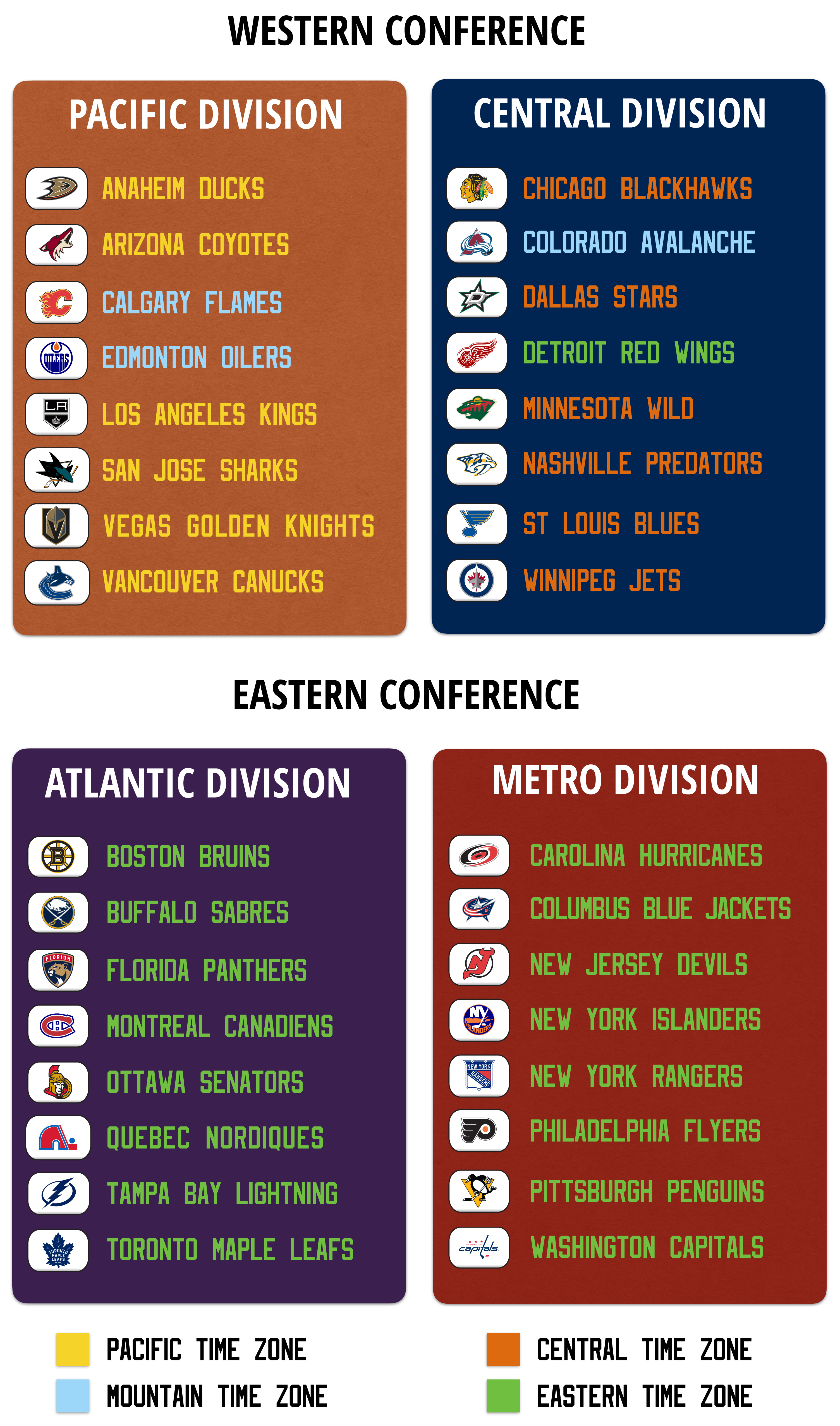
This format makes as few changes as possible: in a Quebec expansion scenario, it returns Detroit to the Western Conference and Central Division, and adds Quebec to the Atlantic in Detroit’s place. In a Seattle expansion scenario (see below), it adds Seattle to the Pacific Division and shifts Arizona to the Central (since Arizona is technically in the Mountain time zone and does not have the rivalry with Vancouver that Calgary and Edmonton do). This is the format that is actually being adopted by the NHL in anticipation of the Seattle Kraken’s arrival.
The disadvantages to this (above) format are that although Detroit has a history with the Central teams and being in the Western Conference, it would make Detroit the only Eastern team not in the Eastern Conference, which is a significant travel and time zone disadvantage. It would be difficult to justify returning only Detroit to the West, since they and Columbus were the most recent Western teams moved to the East, and are both in the Eastern time zone, but Detroit had been waiting much longer for the move, and Columbus’ market may not survive long term with a Western alignment.
If the Central division was only comprised of Central and Eastern teams, this alignment would be less of an issue, it would simply mean Detroit has a significantly more disadvantageous schedule and can occasionally meet Mountain and Pacific teams in the playoffs. However, Colorado, a Mountain team, would have to be in this division as well, making things even worse for Detroit.
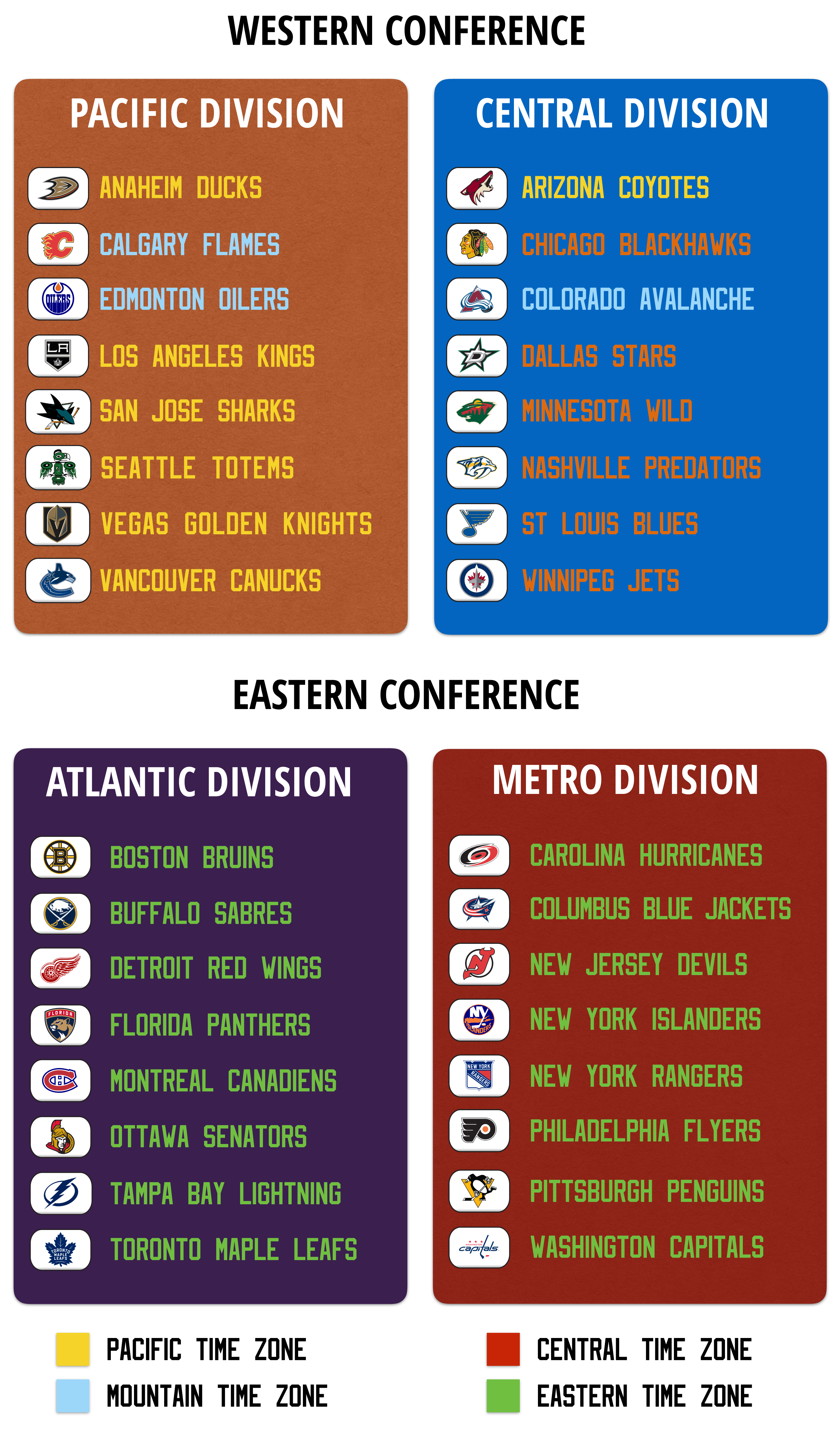
In the Seattle alignment, although Arizona fits the Central alignment during the majority of the regular season, during the playoffs, Arizona is technically a Pacific team as well, since the state does not change to daylight savings time (which lasts from early April to early November). This would cause issues with Arizona drawing Division rivals in the playoffs, as all but one of them are Central teams.
If simplicity and resistance to change were the most desirable factors in realignment, this is the best format, nonetheless, and it appears that it will be.
Colorado-Metropolitan Alignment
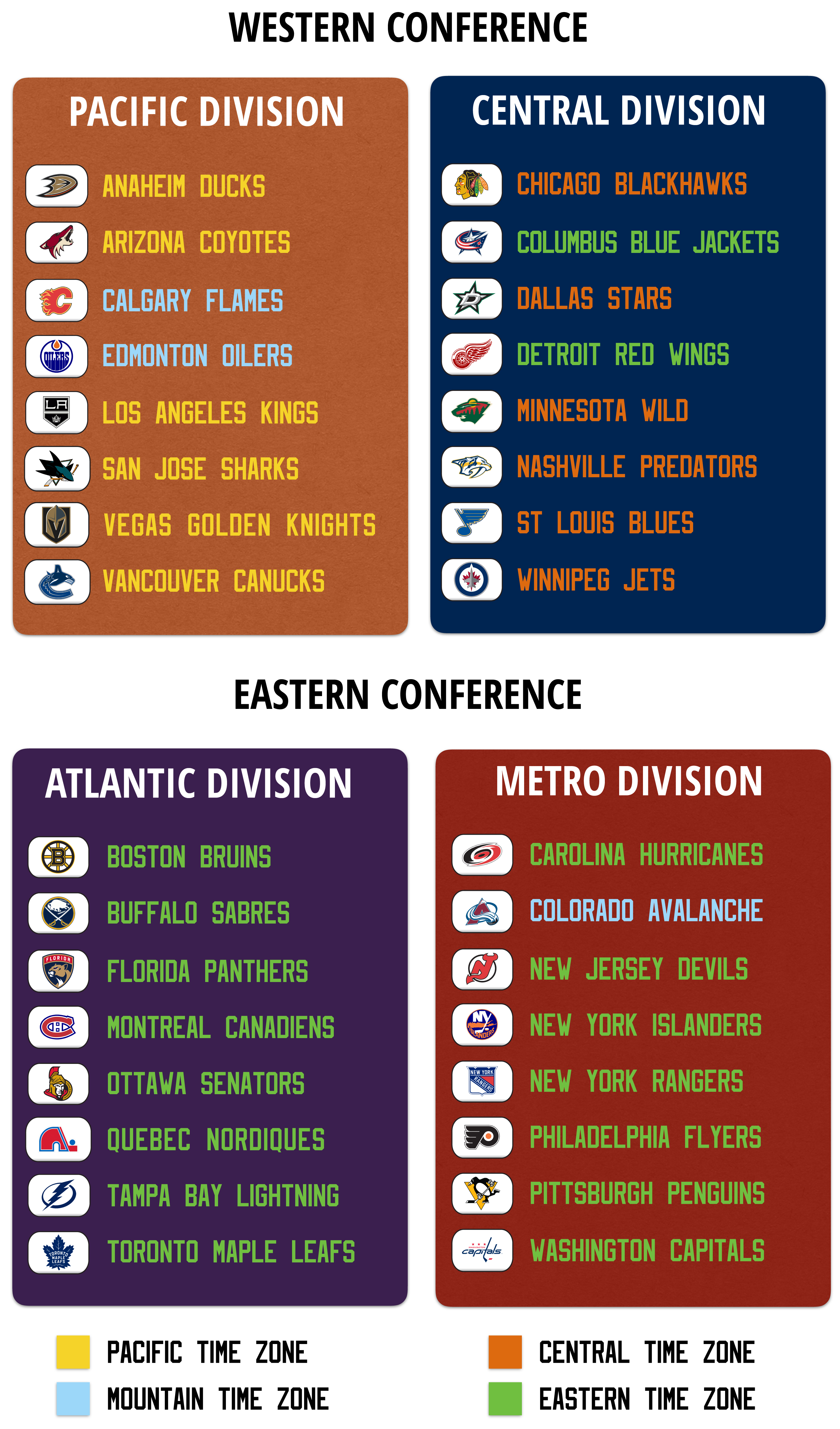
Since Colorado’s unusual placement in the Central division causes a significant problem for alignment, I have considered the possibility of singling this team out and moving them to an Eastern division, despite their Western location. The idea would be to make sure than any Eastern team (such as Detroit) while in the Western Conference could avoid a 2-time zone difference in their Divisional alignment, while placing Colorado in the Division with the least amount of travel between its teams, the Metropolitan.
The disadvantages for Colorado are obvious: every Divisional and Conference road game would be 2 time zones apart from theirs, and they do not have any traditional rivals in this division. However, the advantages would be to have several very large markets as division rivals (New York, Philadelphia, Pittsburgh, Washington) and minimal travel between divisional games on the road.
Some creativity with schedule making, such as having them play road games on the weekends, when fans would likely not be working and could watch the games, and grouping together stops on road trips as much as possible, could help Colorado make due in this alignment.
In the playoffs, it could be a rule that any time teams with 2 or more time zones between them meet, they could use the 2-3-2 playoff series format (2 games in one city, then 3 in the other, and ending with 2 in the first city), so in divisional playoff series, Colorado could minimize the number of long trips to and from the Eastern time zone to Denver.
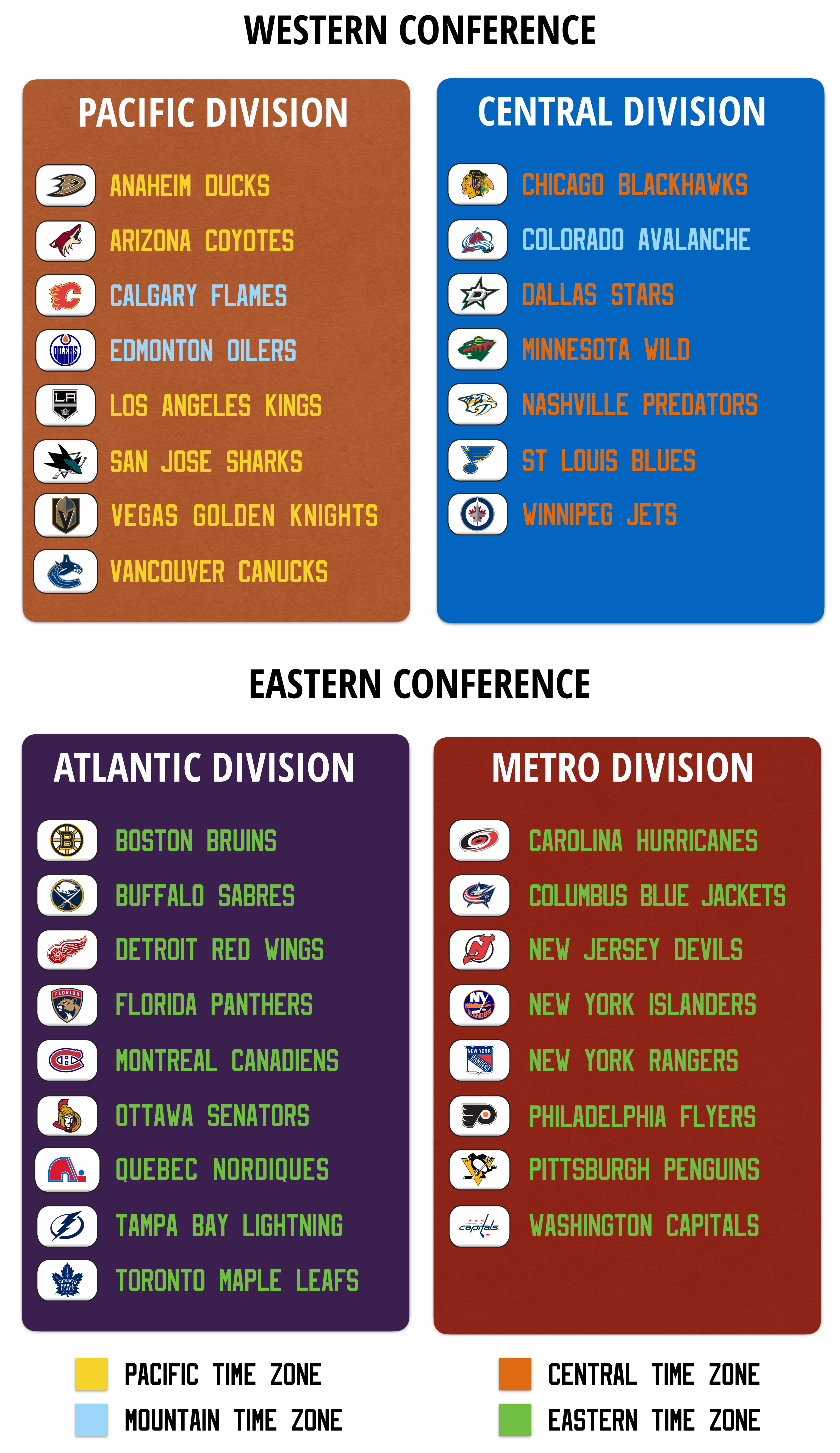
This format ignores the need to make the divisions have an equal number of teams, and instead simply adds the two new expansion teams to an appropriate division and adjusts the schedule accordingly. If it is Vegas and Quebec, the alignment is 8/7/9/8 (Pacific/Central/Atlantic/Metro, shown above) or 9/6/9/8 if Colorado is in the Pacific Division (shown below). If it is Vegas and Seattle, the alignment is 9/7/8/8 or 9/6/8/8 if Colorado is in the Pacific.
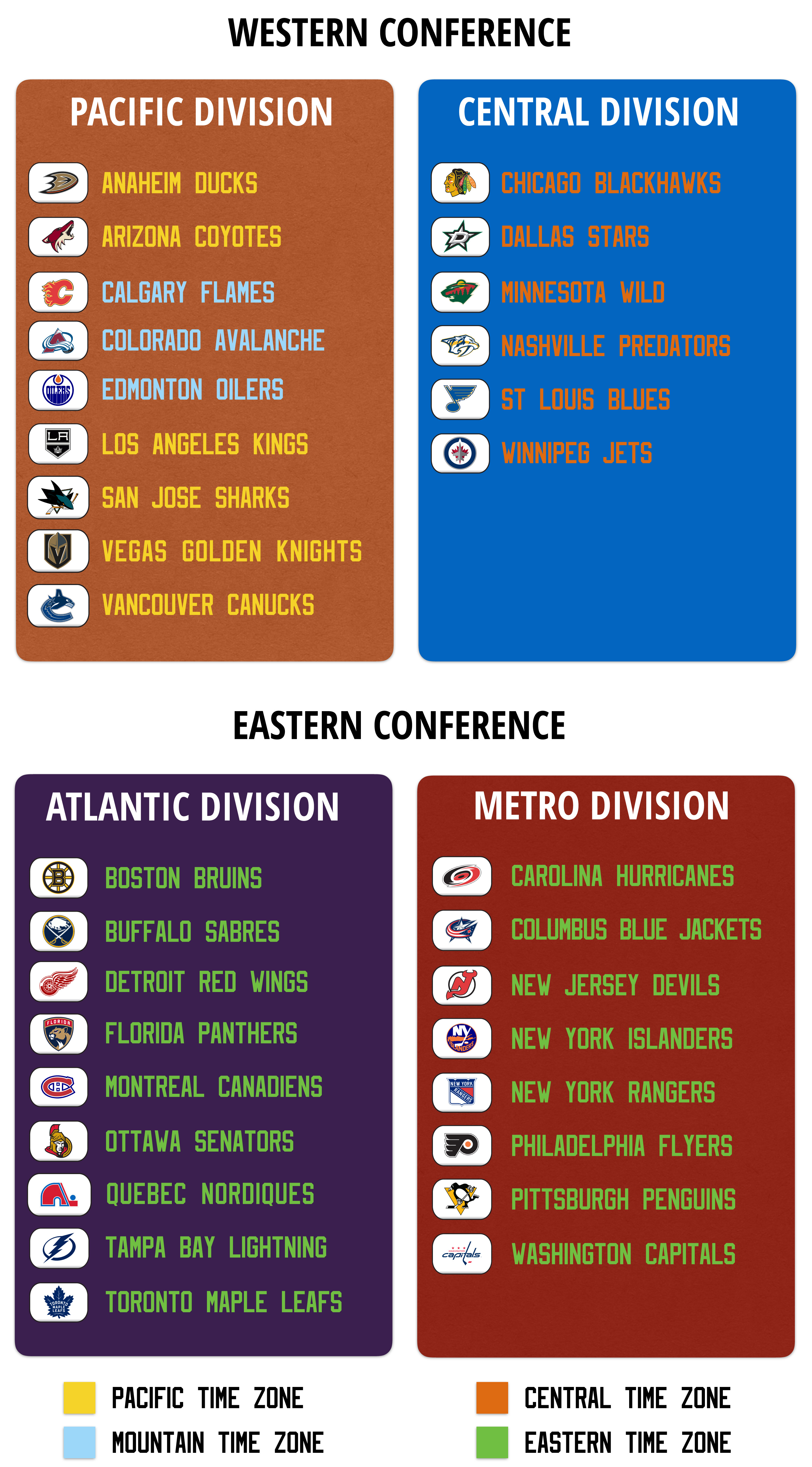
For this alignment to work best, it should be paired with a playoff format that allows equal playoff odds across the league regardless of division alignment, such as one that breaks down playoff spot availability based on the number of teams in each division to make it an equal chance for every team. Both my Time Zone Grouping and Three Conference formats do this, though both have their own alignment formats distinct from this one.
Atlantic Split Alignment (Quebec expansion only)
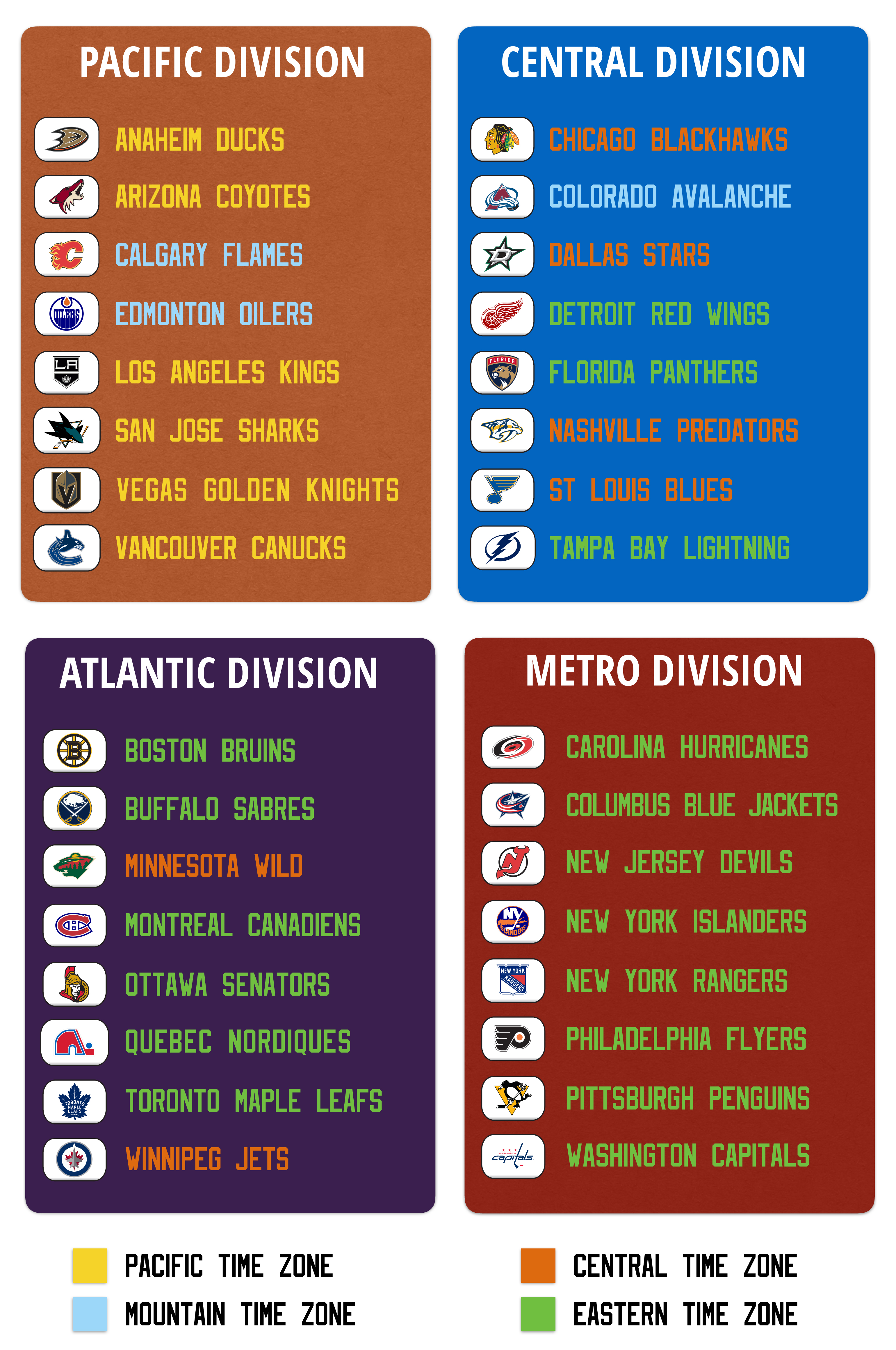
For these next two alignments, rather than minimal changes, I propose significant changes so that the Eastern and Central teams are more blended. This way, no one Eastern or Western team is overly punished in the alignment: they all have several traditional rivals, new rivals, teams from their time zone, and teams from a nearby time zone.
This alignment splits up the Atlantic and Central divisions, placing Winnipeg and Minnesota in the same division as the Eastern Canadian teams, Buffalo and Boston. For Winnipeg, having so many Canadian teams in their division, as well as keeping Minnesota, their closest geographic rival, makes sense. For Minnesota, they keep Winnipeg, they gain three original 6 teams as division rivals, which will draw well, and they have two other American teams in the division, rather than just Canadian teams.
In the Central, the Florida teams are placed with other teams more geographically close to them, reducing their travel, and it still gives them large markets such as Detroit and Chicago as division rivals. The Central still spans 3 time zones, thanks to having Colorado and several Eastern teams, but it is not just one Eastern team, and Colorado keeps some Central rivals, rather than being in an all-Eastern division. The Metropolitan division is unchanged. This alignment eventually led to my Three Conference alignment, once I started thinking about the idea of combining Central and Eastern teams together to gain something.
Metropolitan Split Alignment (Quebec expansion only)
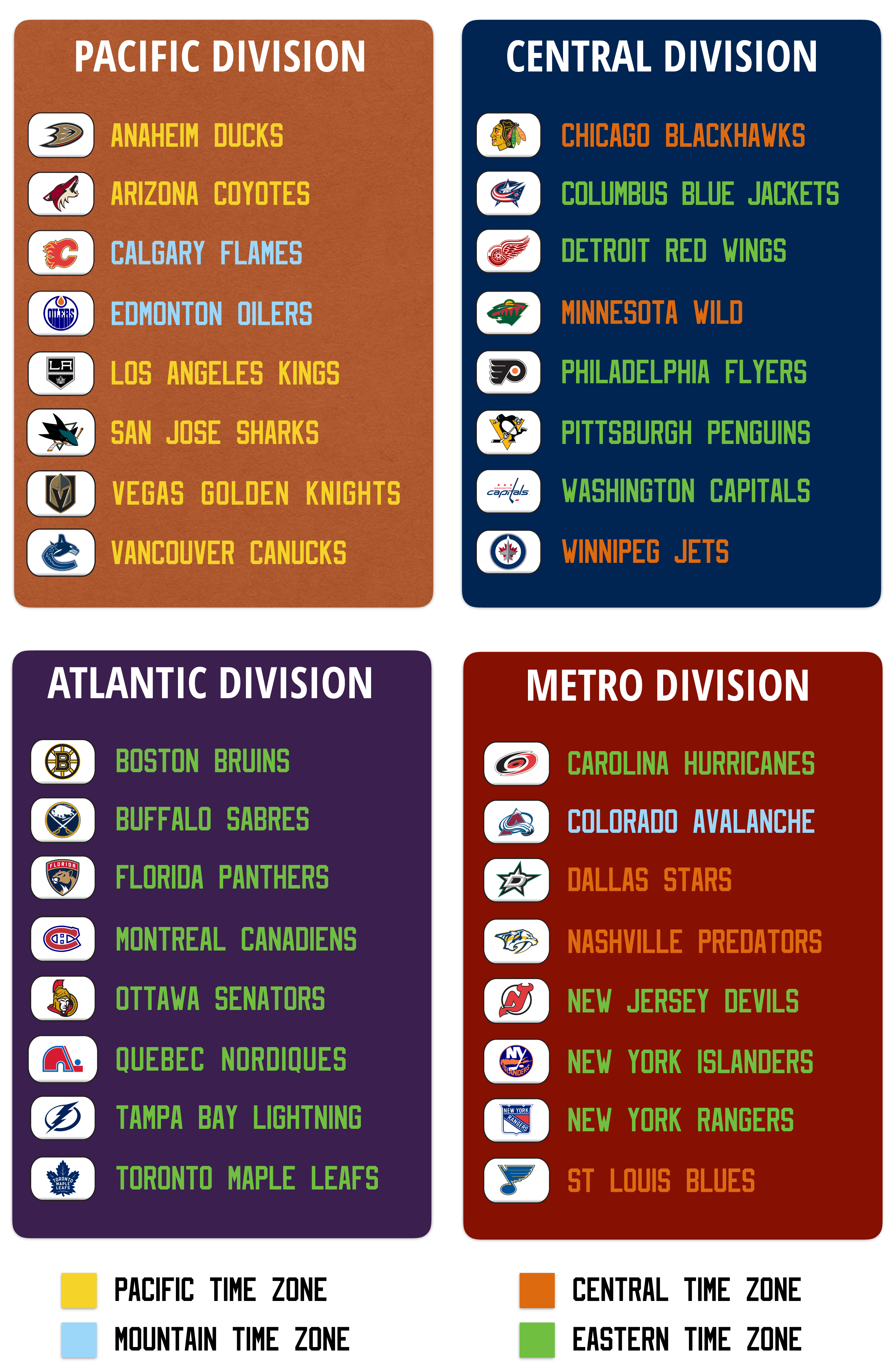
Alternatively, this alignment splits up the large markets in the Metropolitan division, and keeps the Atlantic division intact. Colorado once again is placed in a division with the New York area teams to minimize road travel in a far away time zone, but they get 3 Central teams along with them. Detroit avoids a 3 time zone division, with only Central and Eastern division rivals.
Pittsburgh, Philadelphia and Washington are separated from their traditional rivals in New York, but are given Detroit and Chicago instead, along with some smaller markets that will benefit from all the more established rivals in the division with them.
This approach mimics the strategy of some of the early division alignments that the NHL employed once the league grew past 14 teams: these divisions spread out travel about evenly, because there were too few teams (just Vancouver, Los Angeles and St. Louis) outside the northeastern areas of the U.S. and Canada to create a Western division that wouldn’t be at a huge disadvantage (travel and expenses) compared to the others if mapped out geographically.
Here, the metro New York teams have Colorado, Dallas, Nashville and St. Louis as Division rivals, the Atlantic division still includes Florida and Tampa Bay, and the Central division has some East coast teams to balance out the travel. It also spreads the Big 8 markets out quite effectively: Los Angeles in the Pacific, Chicago, Detroit and Philadelphia in the Central, Toronto, Montreal and Boston in the Atlantic, and NY Rangers in the Metropolitan.
Western Canadian Split Alignment (Seattle expansion only)
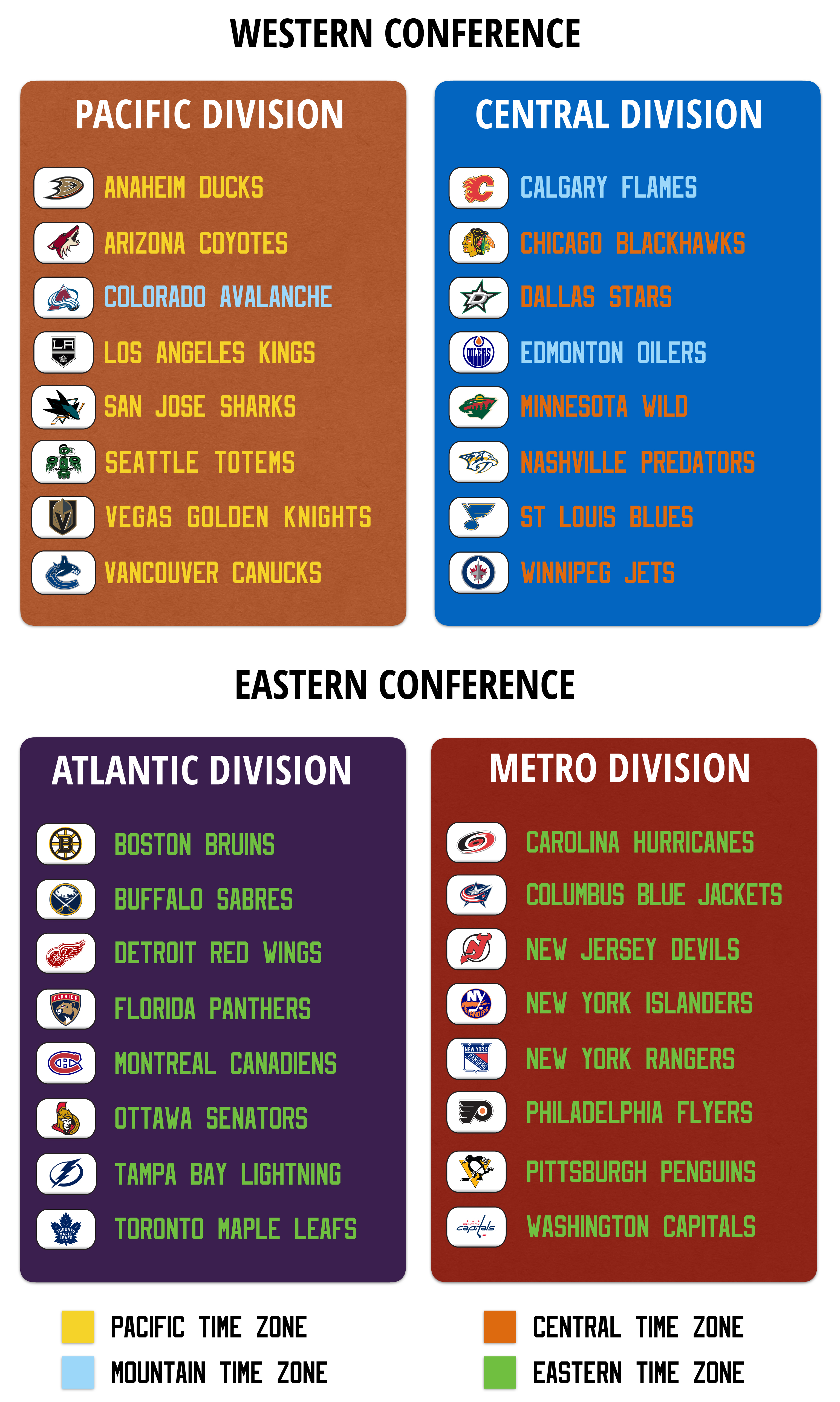
Adding Seattle would mean having 7 Pacific teams in an 8-team division format, so there is no way to keep Vancouver with Calgary and Edmonton (two Mountain teams) without sending a Pacific team (such as Arizona or Vegas) to the Central division, which creates a Division that spans 3 time zones.
So, this alignment swaps Calgary and Edmonton with Colorado, then adds Seattle to the Pacific. For the Alberta teams, having Winnipeg as a division rival, as well as Chicago, is interesting, but perhaps not as desirable as having Vancouver. For Vancouver, Seattle softens the blow of losing the Alberta teams, at least a little bit.
A natural extension of the 4-conference model would be to break the conferences down into 2 divisions each, presumably to use a playoff format that makes things more rivalry-focused, Here is how I would do this for each of the above alignments:
Minimally Changed (Quebec Expansion)
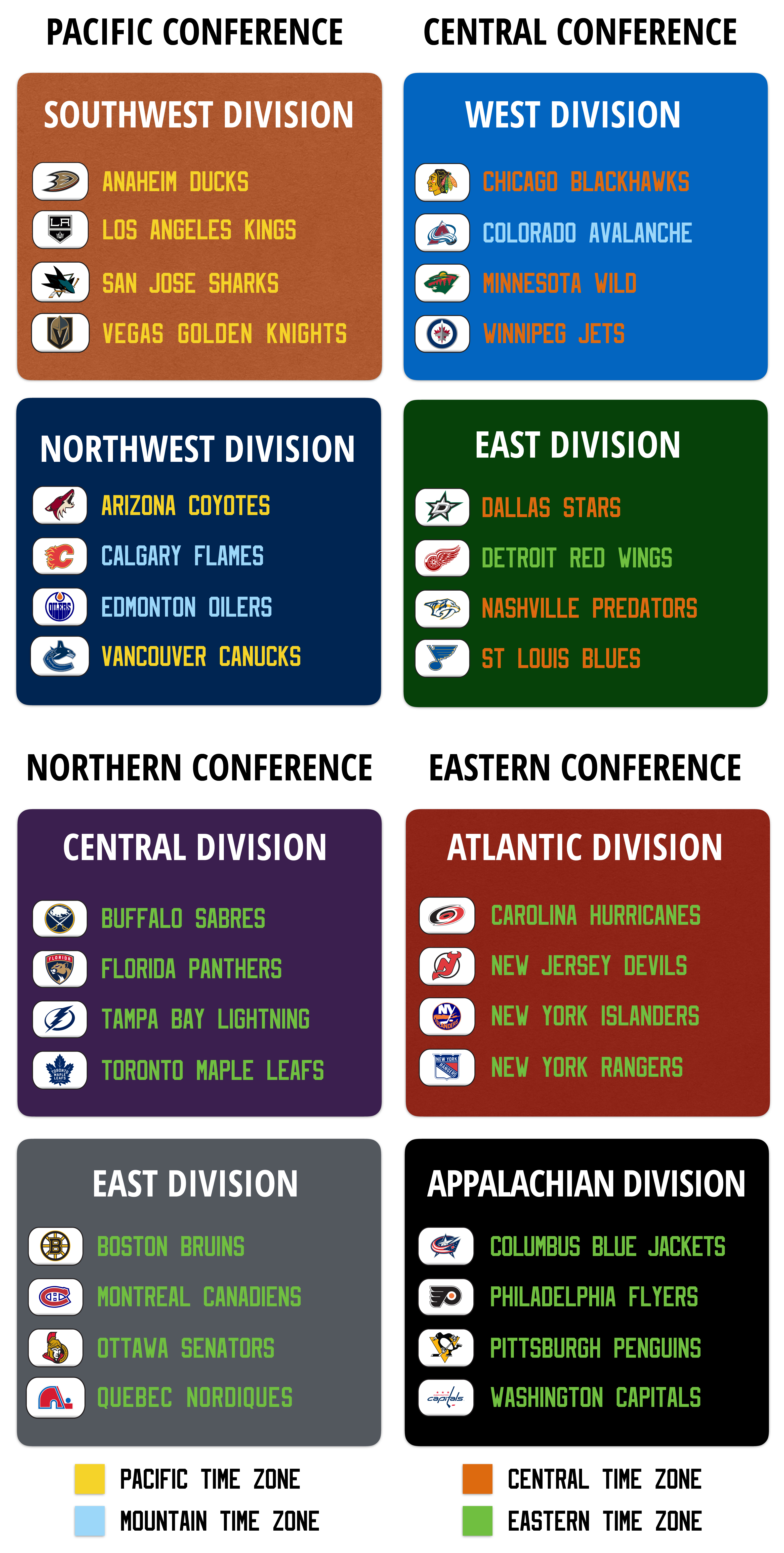
Minimally Changed (Seattle Expansion)
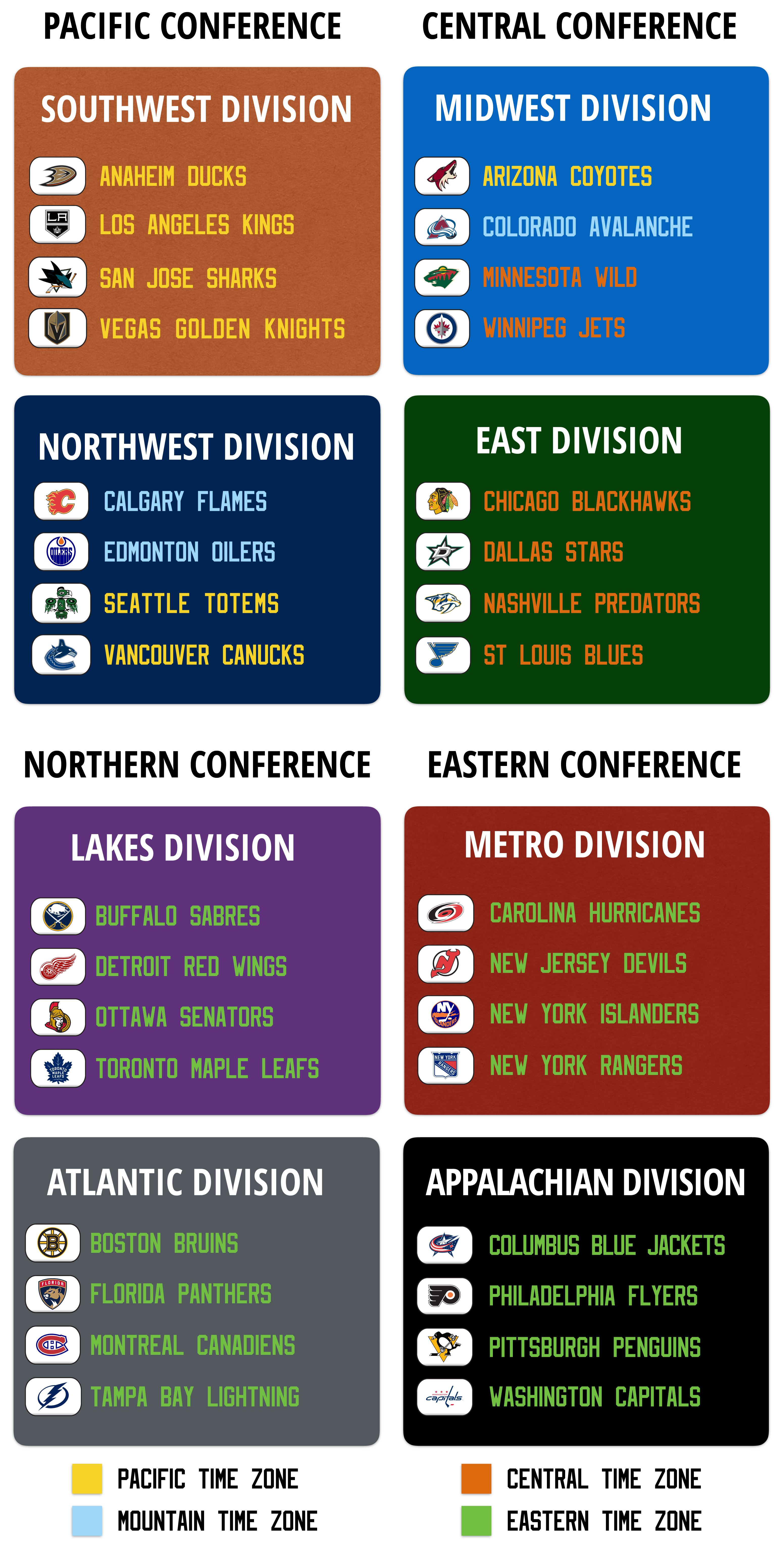
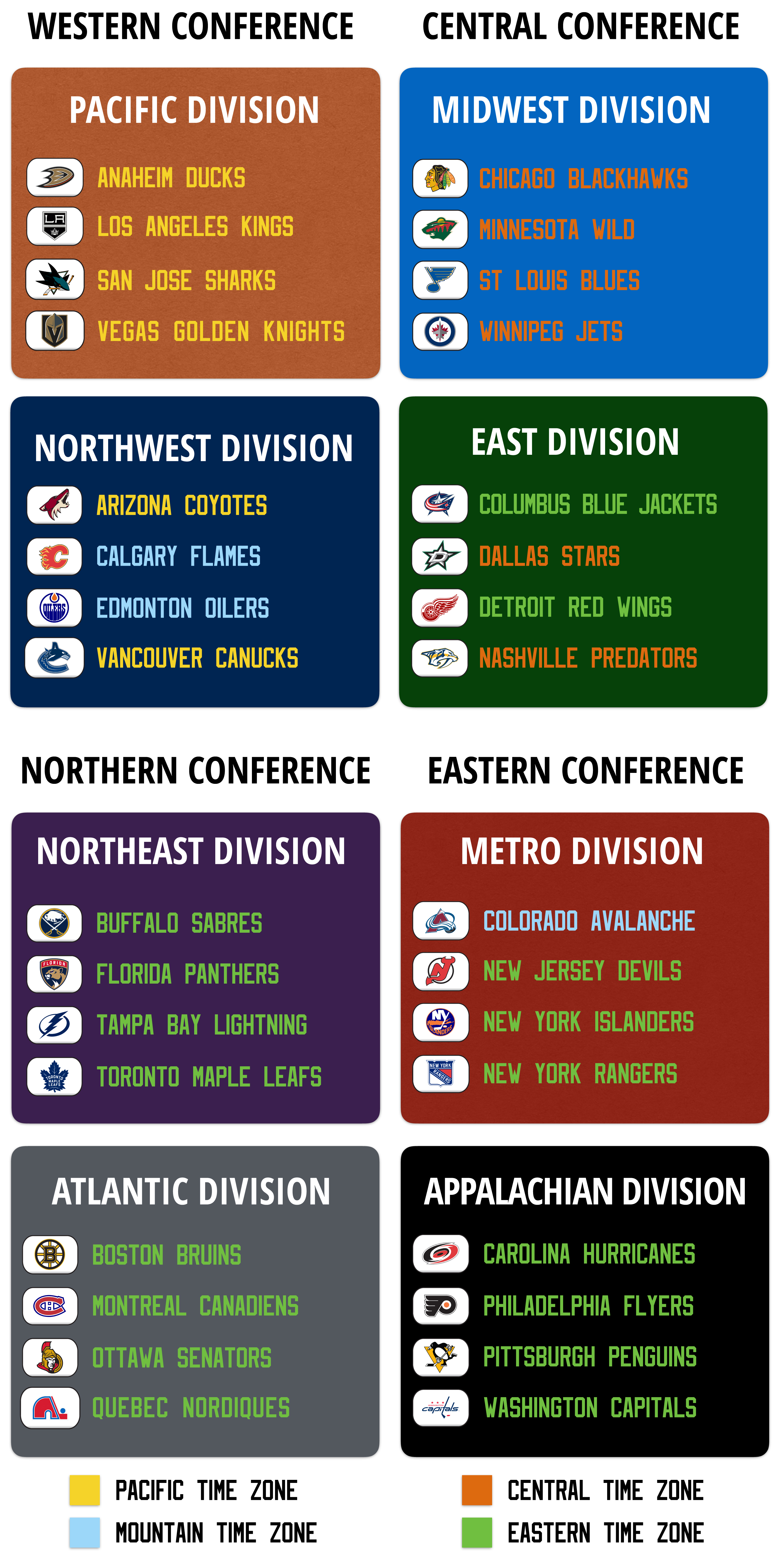
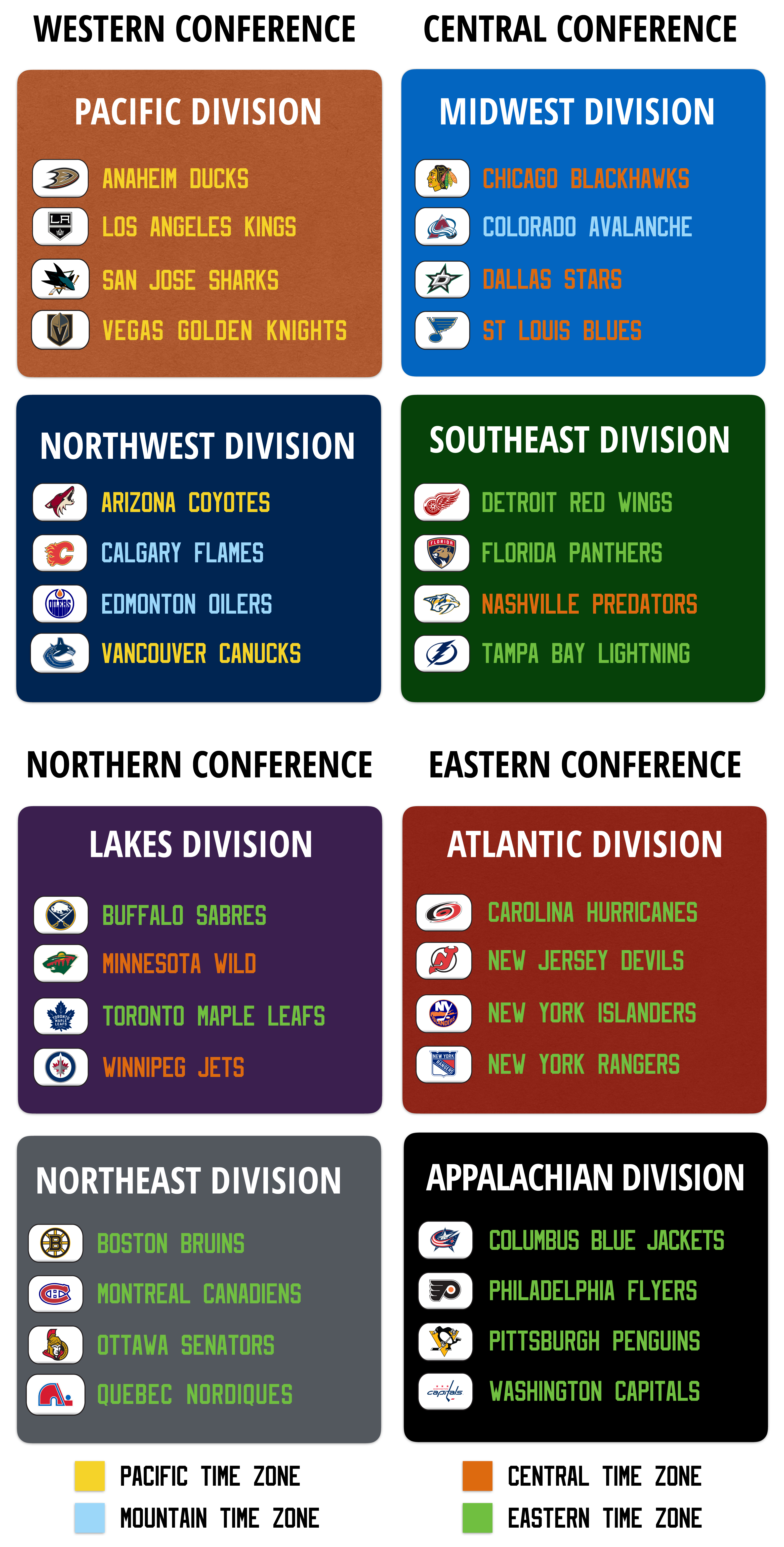
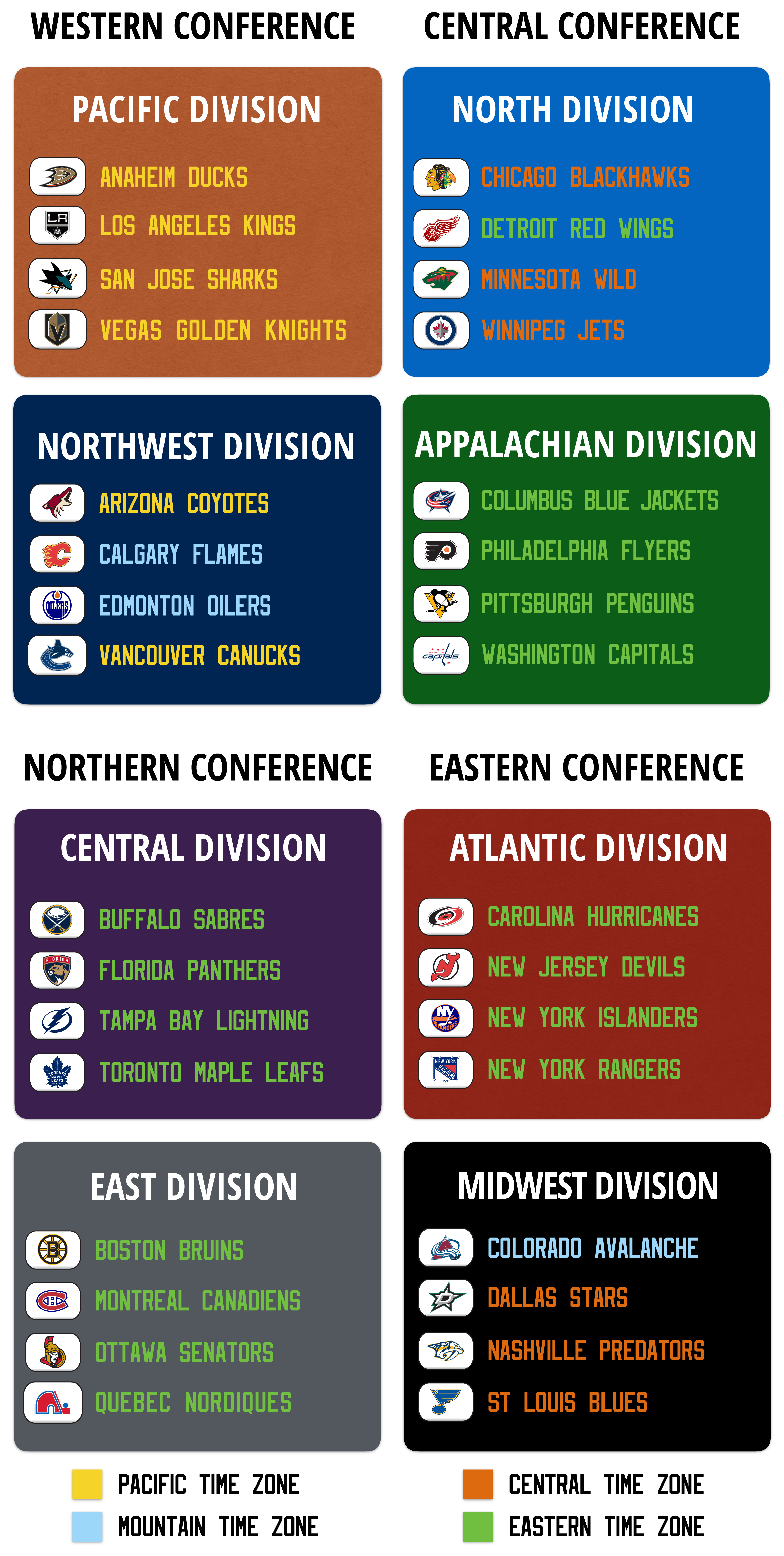
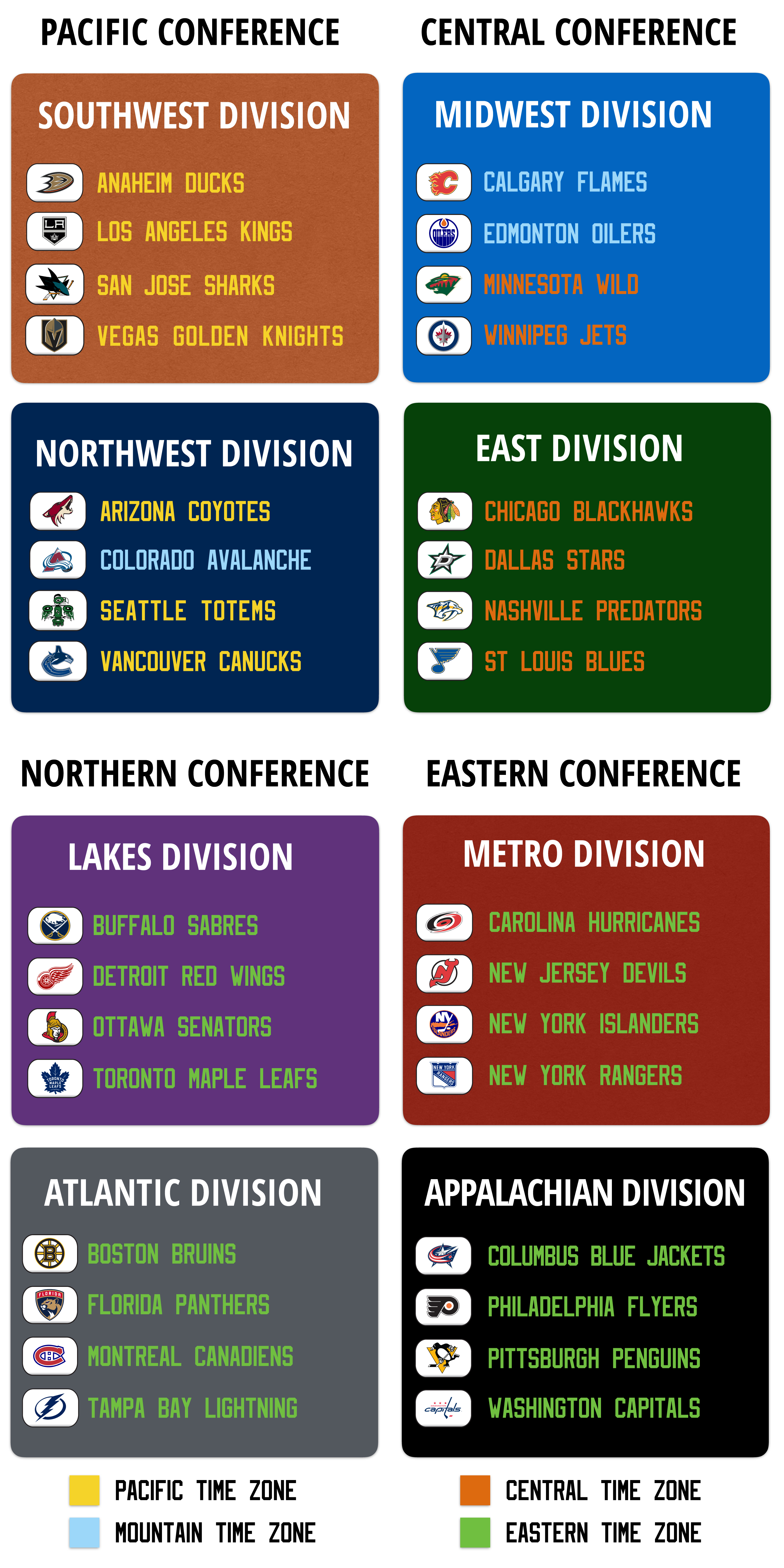
5 Division/Conference Formats
A format with 5 divisions or conferences is a very out-of-the-box idea, but I feel as though it is worth exploring. The natural issue here would be handling crossovers in the playoffs, and making it easy for fans to grasp how the playoff format will work:
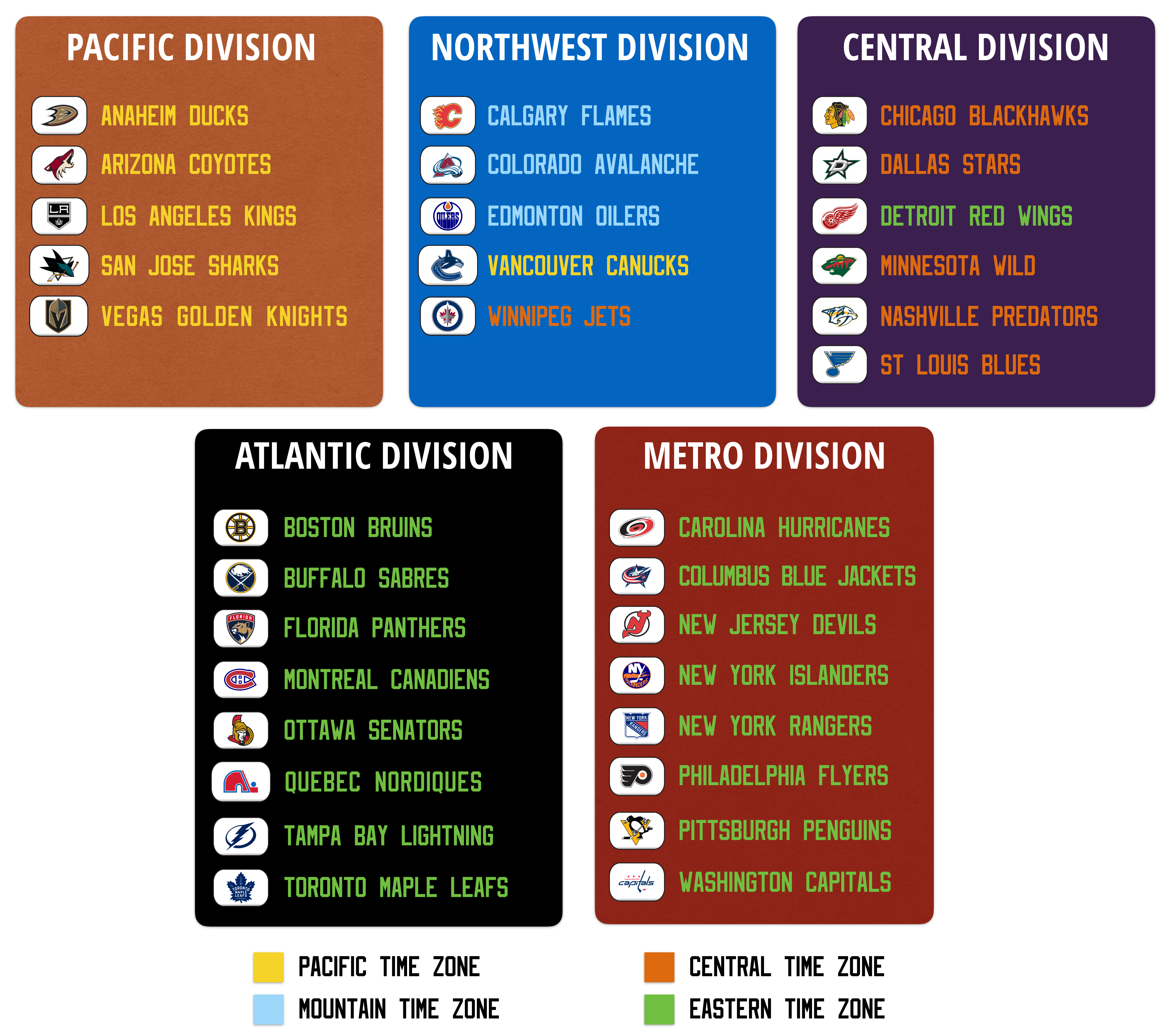
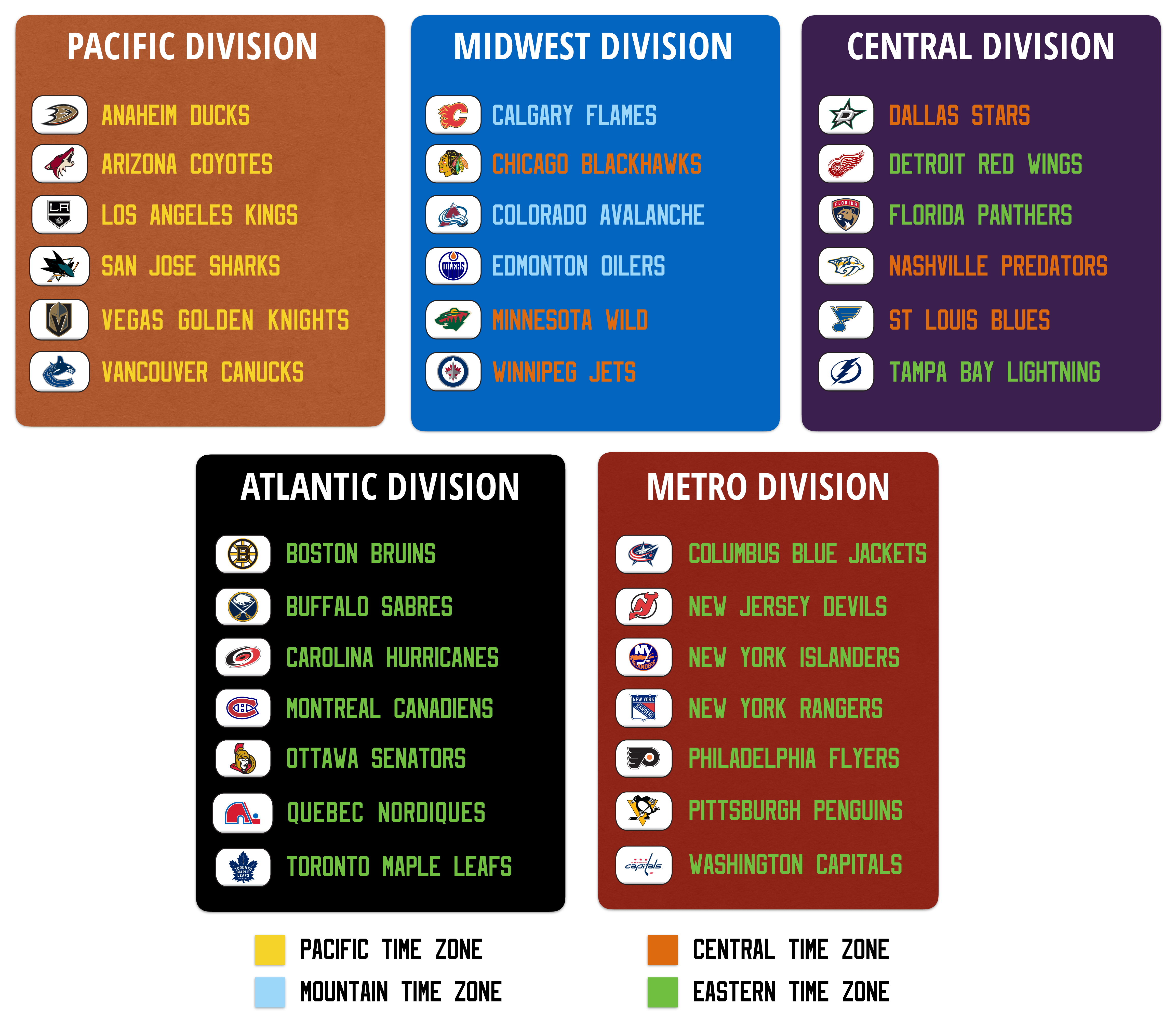
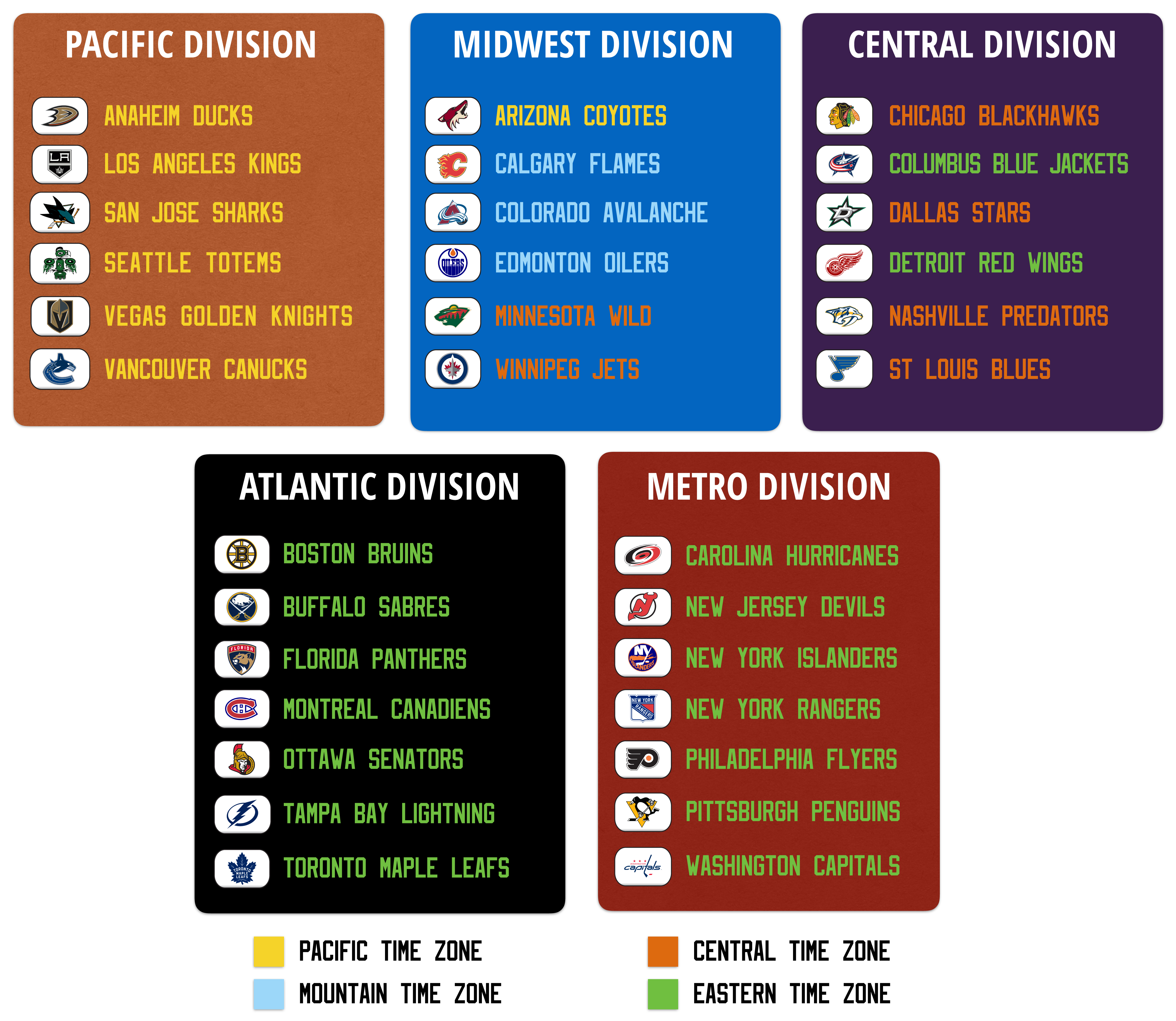
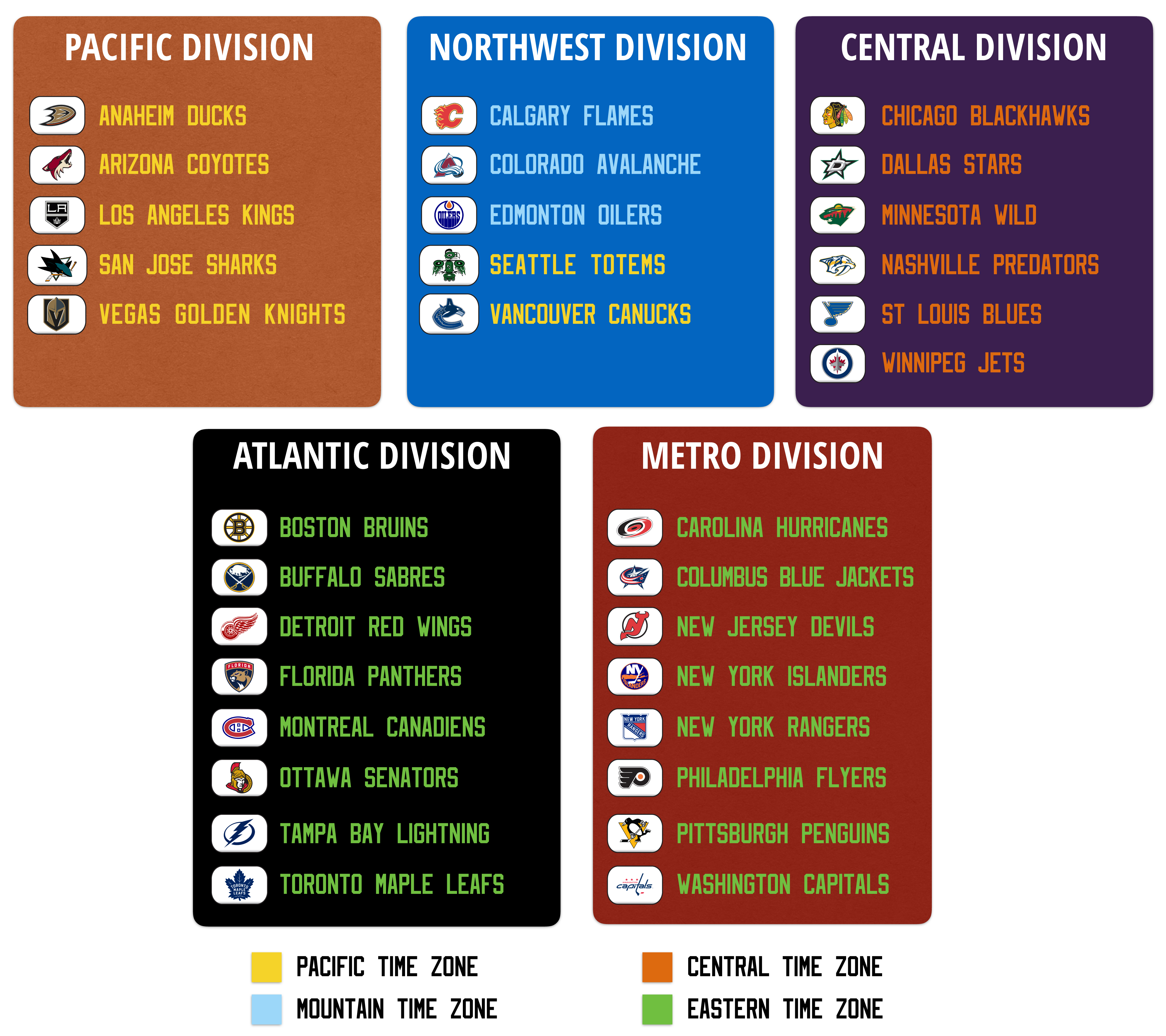
Another interesting possibility for a 5 division NHL would be expanding beyond 32 teams to 35, then aligning so that each division has 7 teams, for example (Hamilton/Houston names/logos are purely speculative on my part):
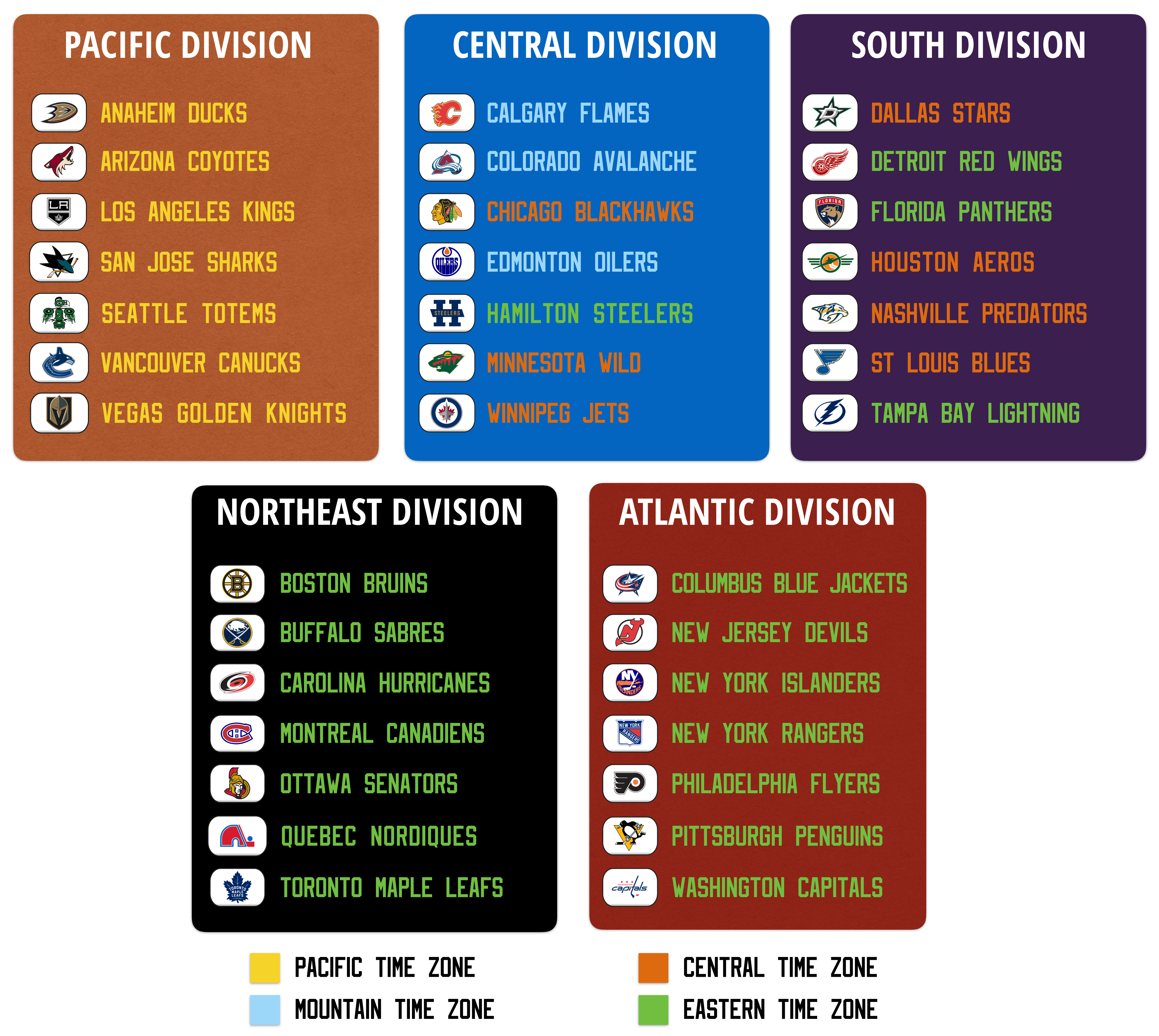
The NHL was a 6-division league from 1999 to 2013, however, it was not an ideal format for the league at the time. To avoid separating Vancouver from Calgary and Edmonton, Dallas had to join the Pacific Division, which had all 4 other teams in the Pacific time zone (causing lots of 9pm road start times for fans in Dallas), and Minnesota had to join the Northwest Division, which included Vancouver (another 3 time zone division).
The structure of the NHL today, with Vegas, and especially considering the potential expansions and relocations to Seattle and Quebec City, and the prior move of the Atlanta Thrashers to Winnipeg, make 6 divisions a worthwhile format to look at again:
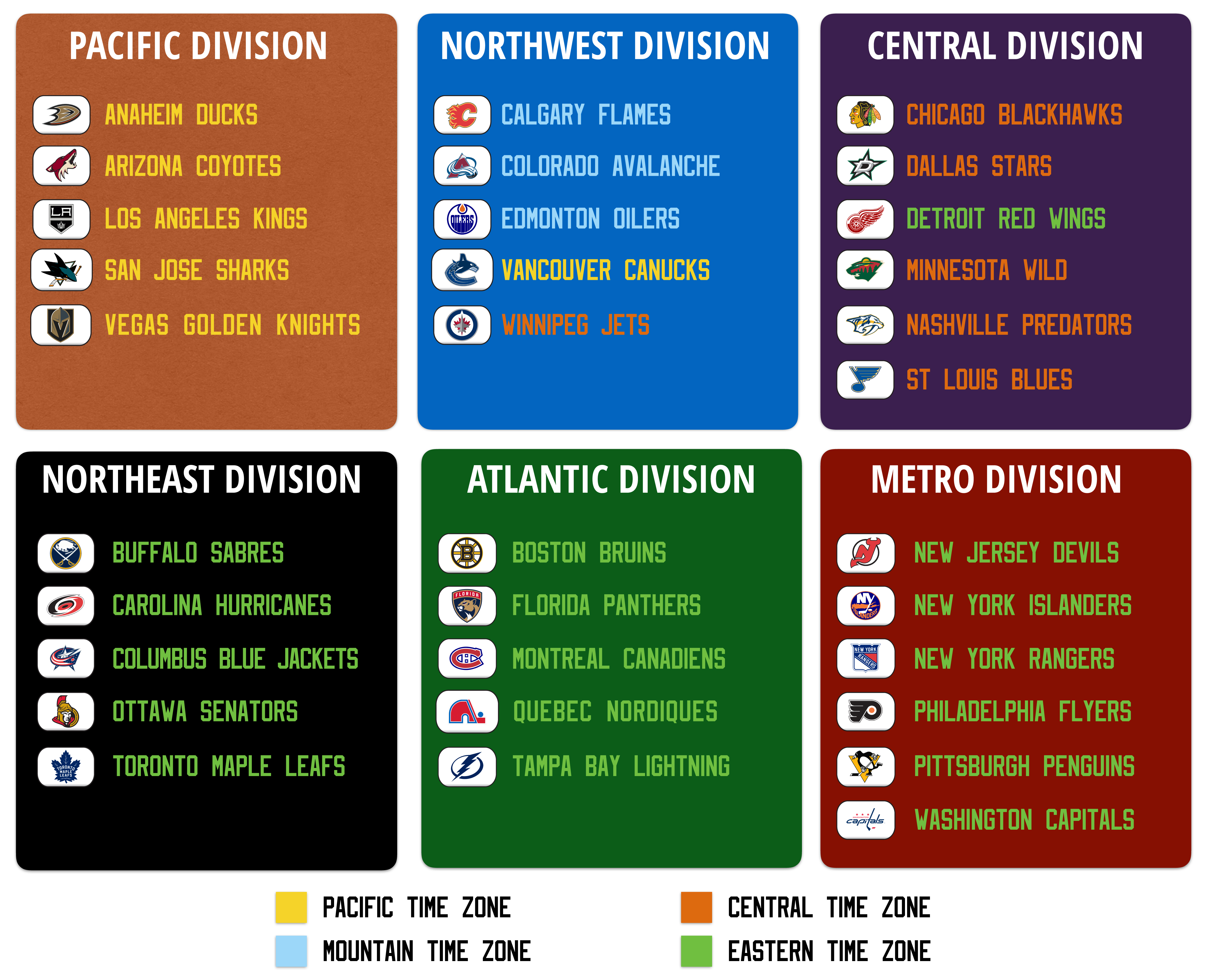
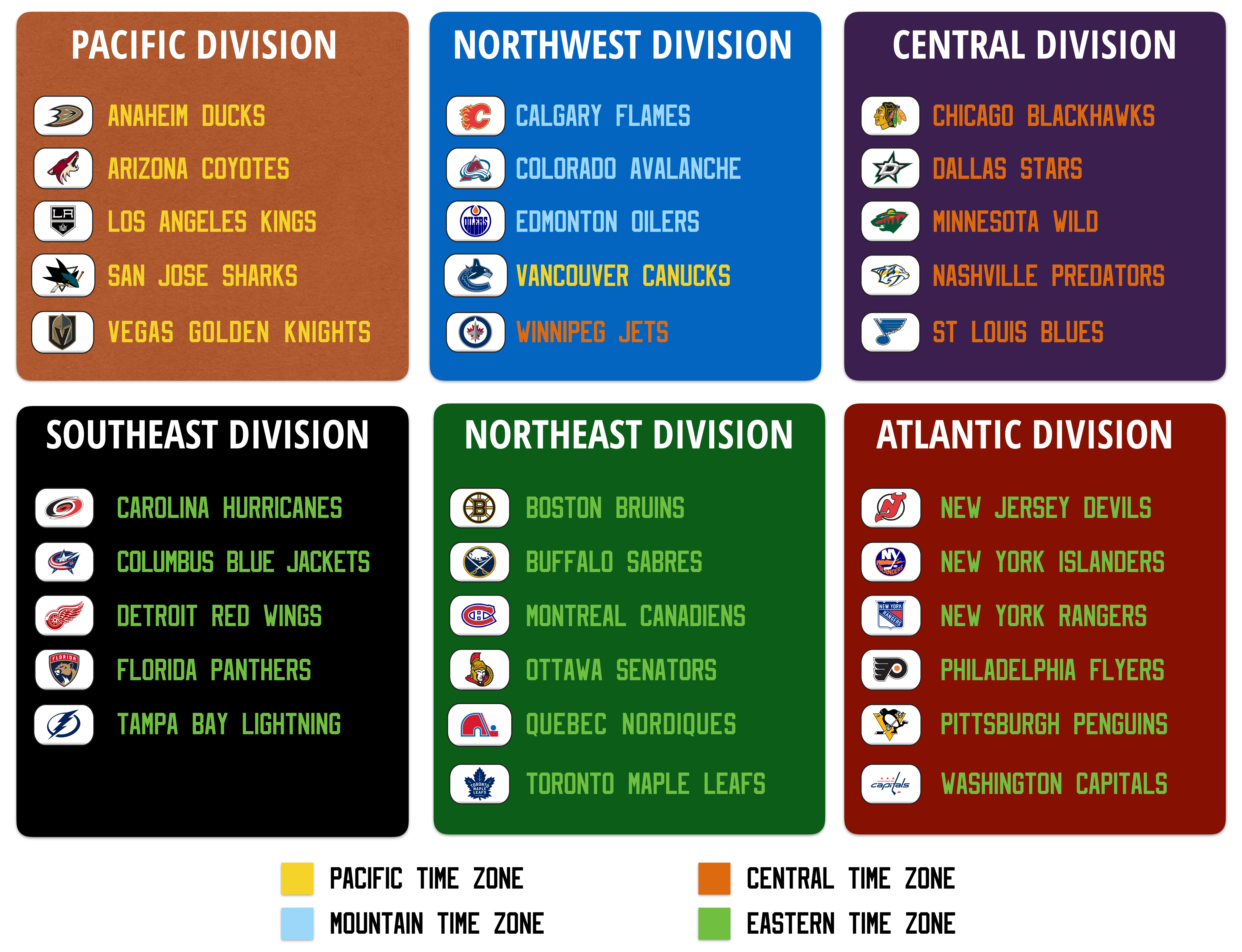
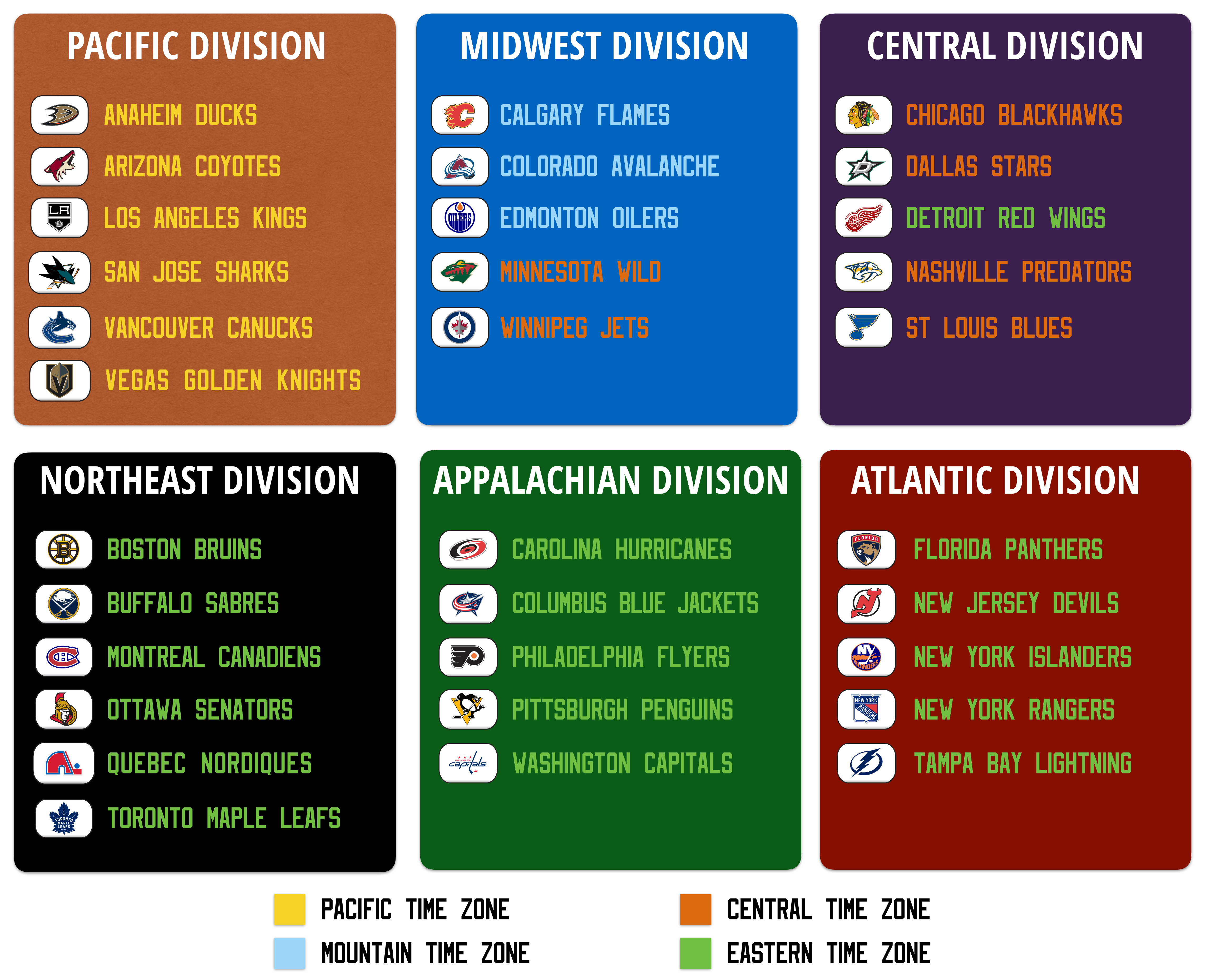
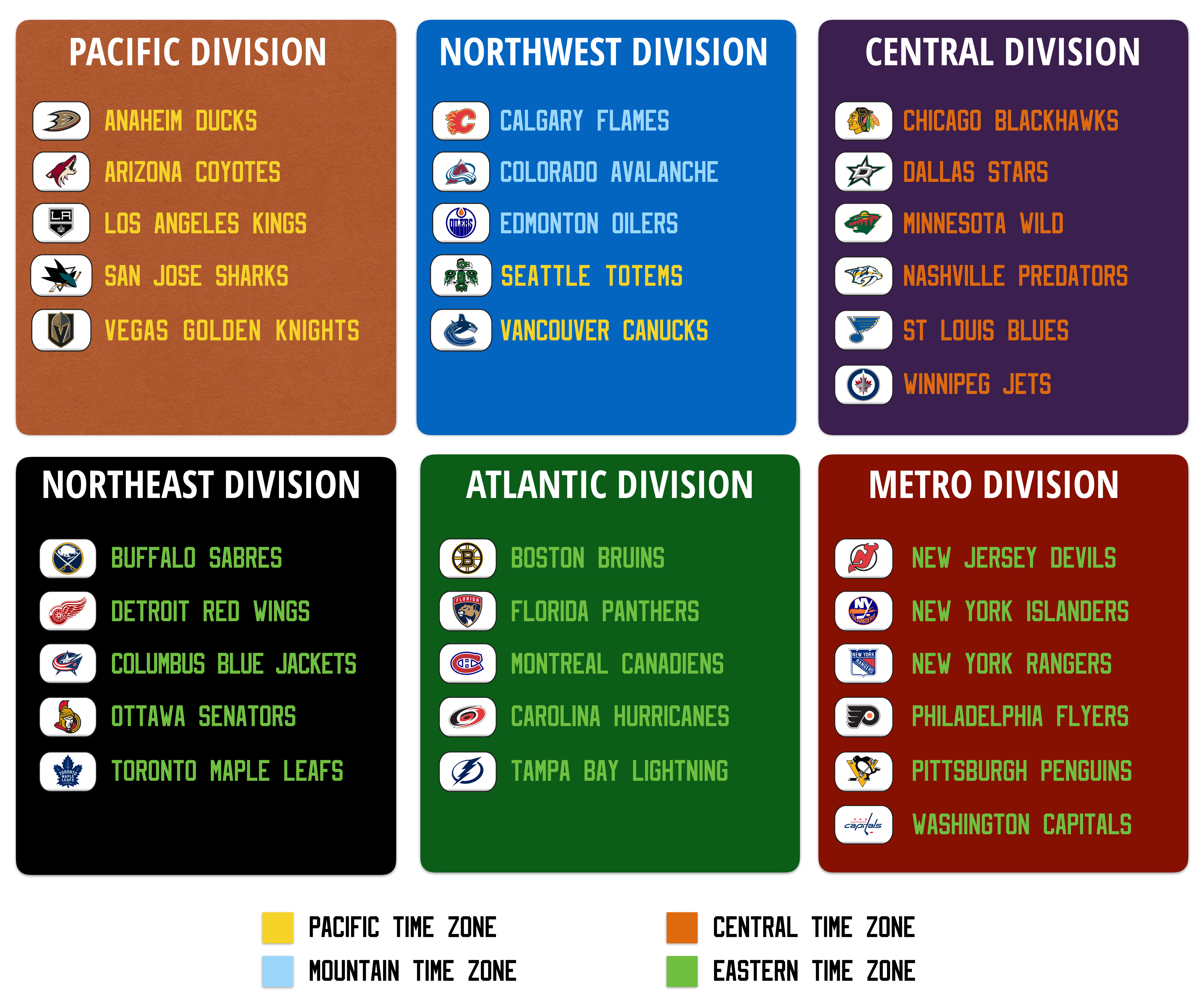
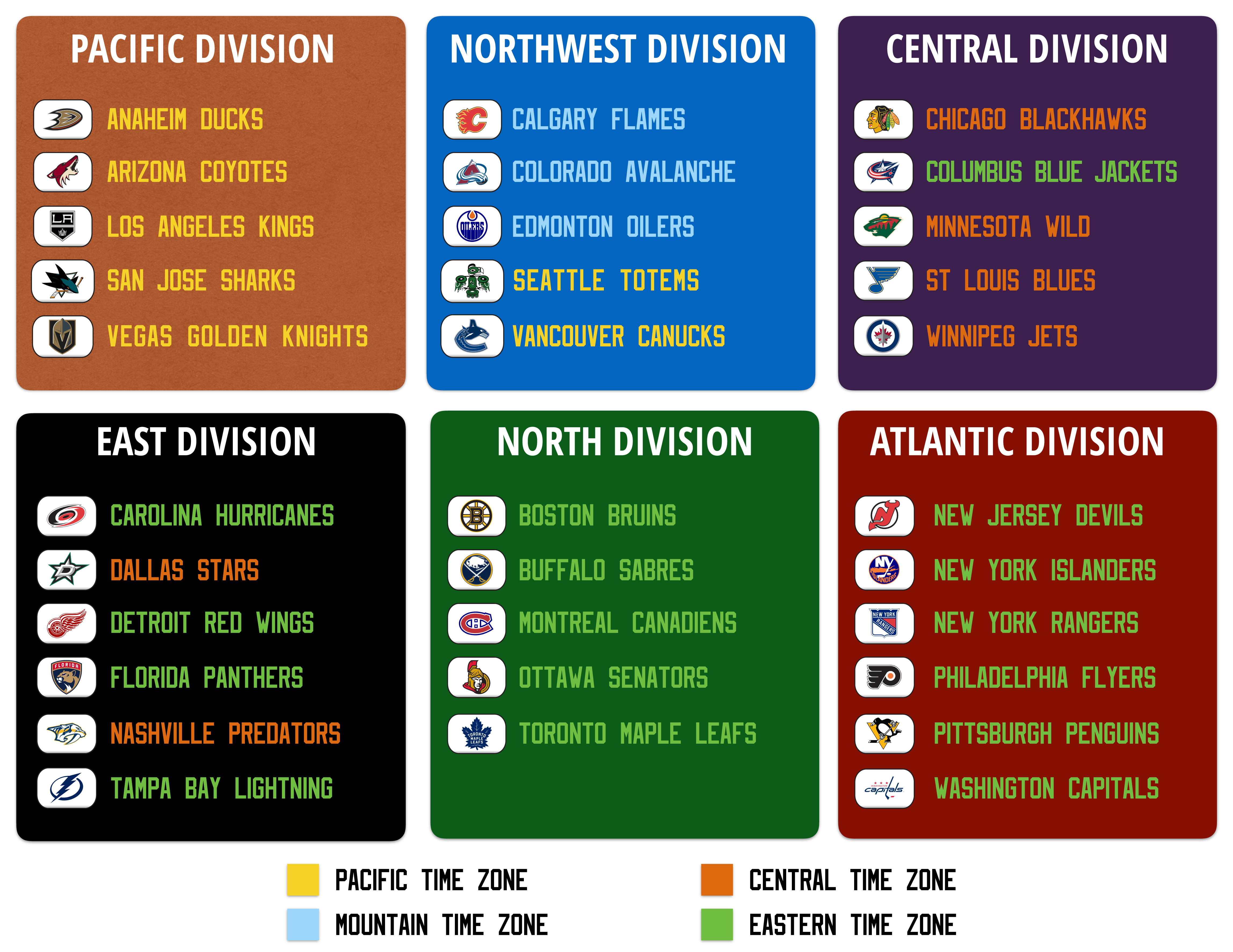
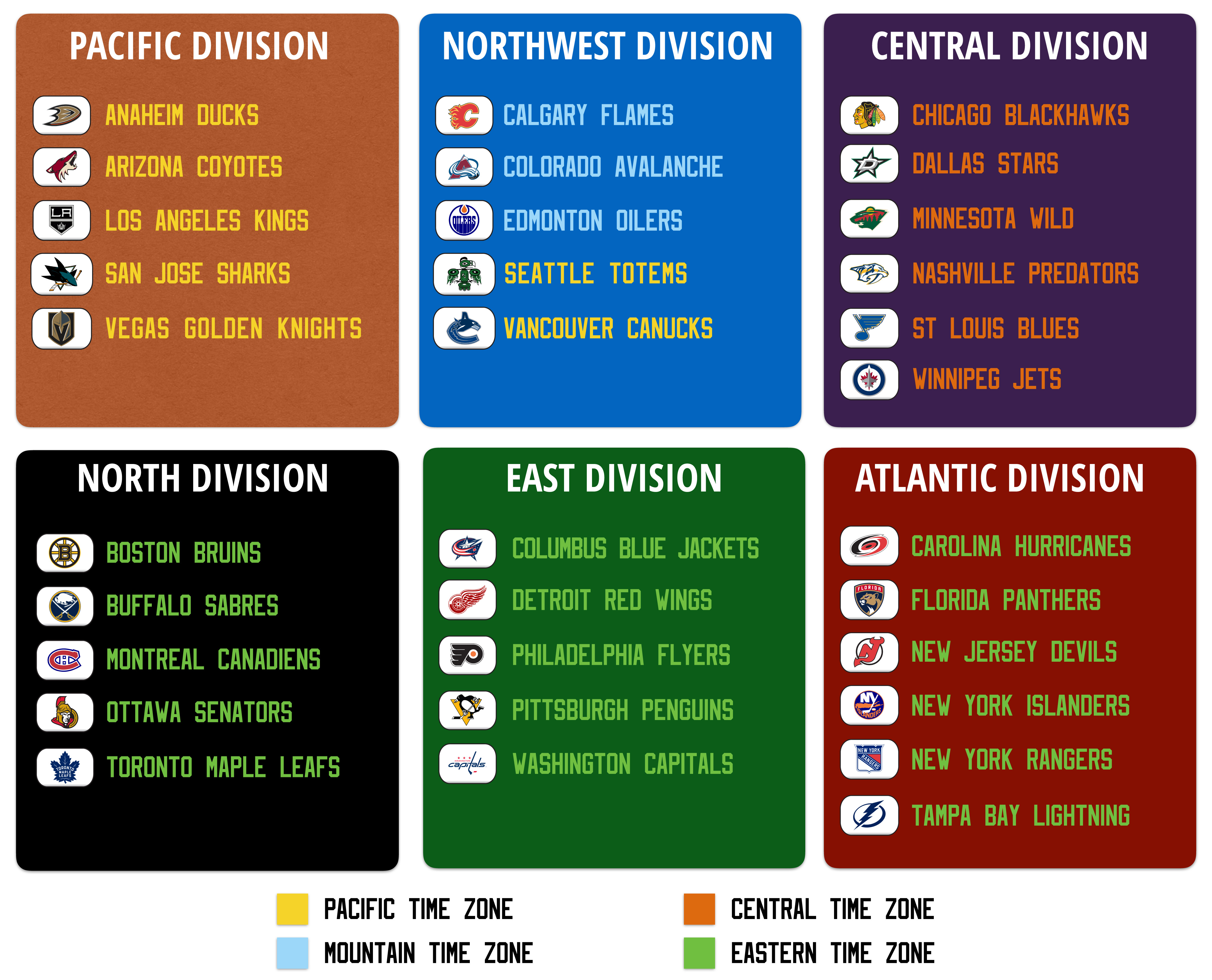
Even more irregular than 5 divisions/conferences, having 7 groups would be very difficult for casual fans to understand. For this reason, this idea is the most blue-sky and unlikely to be used. However, it also allows the unique idea of a 35-team NHL to be quite feasible, despite such a strange number.
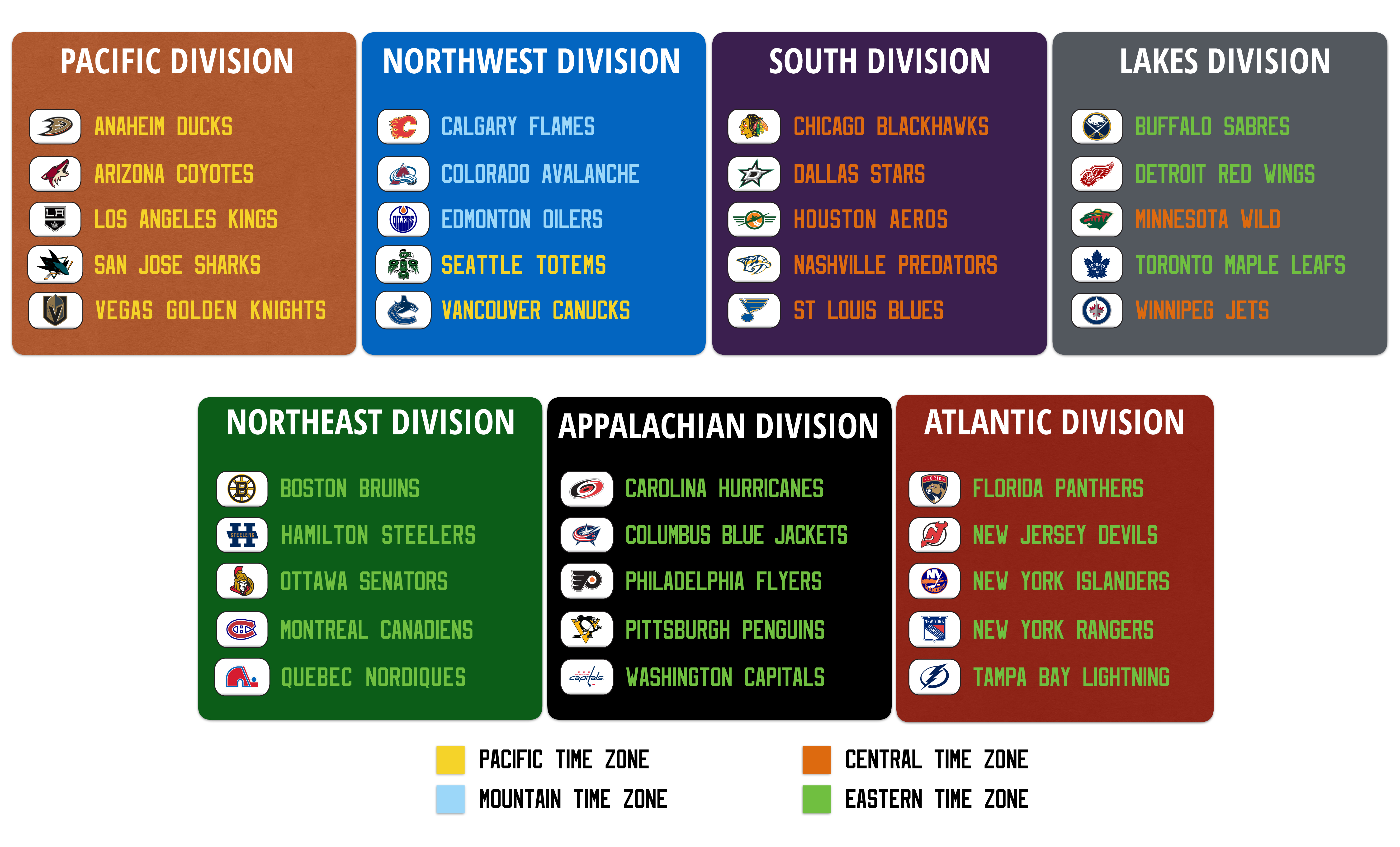
This is a completely unique format that does not involve conferences and divisions at all. It is the predecessor of my A/B Rival alignment/playoff format, with two different initial variations of this idea:
In a 32-team league, each team has 9 other teams who are considered “Rivals”, meaning they play more games (4) against these 9 teams each year than against every other team in the league (only 2). In a 31-team league, teams would get 10 Rivals, and in a 30-team league, 11. This is shown in the images below, with Rivals being indicated by team logos being adjacent to each other, or by being connected by coloured lines:
Each team has only 7 Rivals, but 3 of them are “A-Rivals”, who play each other 6 times per year, and the other 4 are “B-Rivals”, who play each other 4 times per year. Every other team plays each other only 2 times per year. Like the 9-Rival version, the number of Rivals and number of games played against them can be altered to fit a 31 or 30-team league as well.
Since the Rival teams do not have to match between set groups of teams (i.e. as with divisions), there is a tremendous variety of rivalries that could be taken advantage of with this format, and a great focus on maximizing the regular season matchups most significant to fan interest.
The diagrams below show my proposals for the scenarios involving Quebec receiving the 32nd (top) and Seattle receiving the 32nd team (bottom). In these images, teams whose logos are adjacent to each other are A-Rivals (6 games per year). Additional A-Rivals are shown with red lines connecting teams, and the blue lines indicate which teams are B-Rivals:
This allows each team in the league to adopt a schedule that concentrates more on matchups of interest, instead of being tied to sharing a grouping with teams who are merely rivals of their rivals. For example, Columbus must play New Jersey more times than Detroit or Chicago because they share a division with Pittsburgh. The reason is that Columbus’s main rival is Pittsburgh, who is also in the same division with New Jersey, but has a much bigger rivalry with them. Meanwhile, Detroit is one of Columbus’ next most prominent rivals, but Columbus cannot be aligned with them without losing Pittsburgh.
In this alignment, Columbus gets the best of both worlds (games against teams like Pittsburgh and Detroit along with St. Louis, Toronto and other relevant opponents), while Pittsburgh can still get more games against Philadelphia, the New York Rangers, and others whom Columbus would not consider prominent rivals.
All logos © National Hockey League or respective owners, used for purpose of graphic aid only
Ice background © Artsfon wallpapers



























